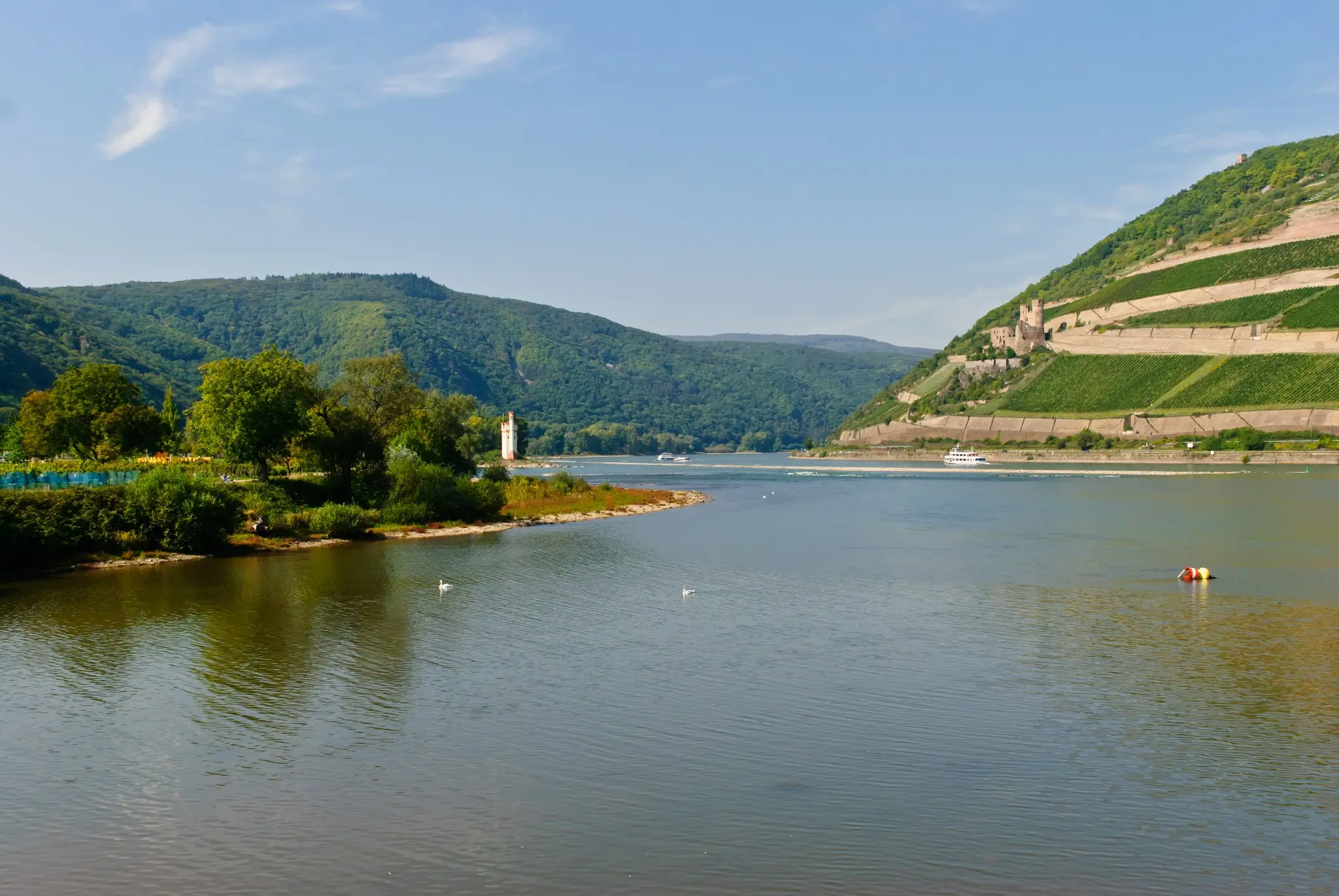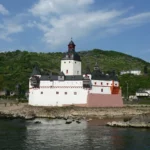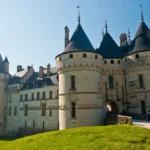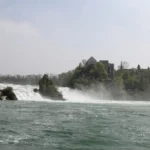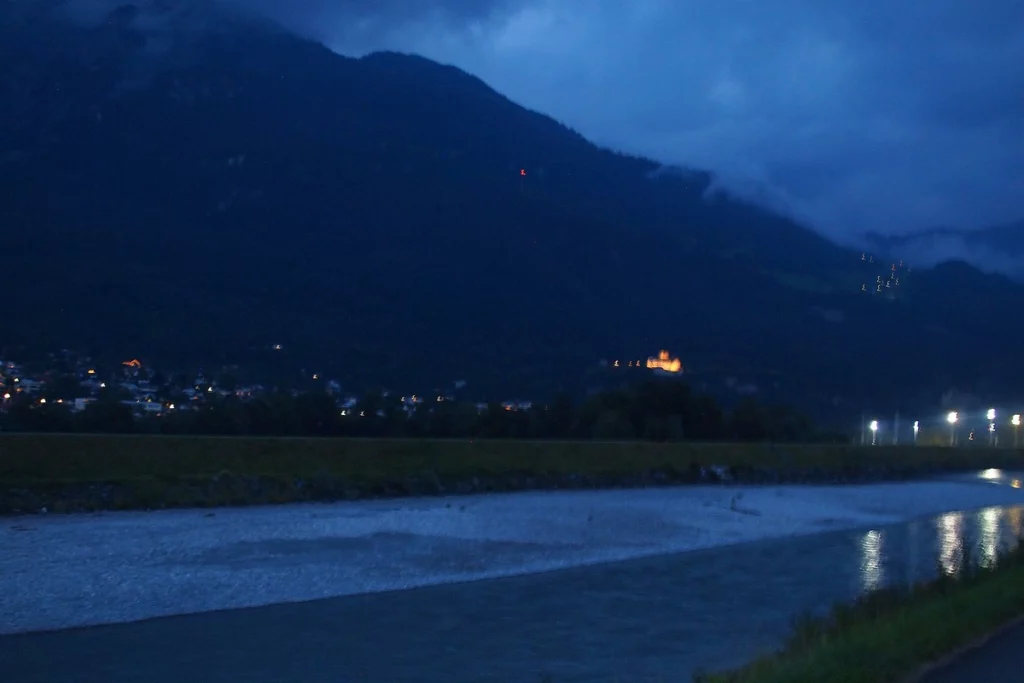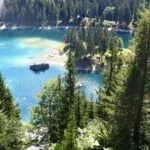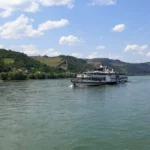Last Updated on 20/07/2023
If we speak about the castles on the Middle Rhine (Mittelrhein), we mean the section from Rüdesheim (slightly downstream from Mainz) to Bonn. From Rüdesheim to Koblenz, the banks converge, forming the Rhine Gorge. This section is also called the “Loreley Valley” (Tal der Loreley). There are many castles of varying degrees of destruction / restoration. We will go through all the castles, briefly tell what happened to them and whether there is something interesting inside.
Rhine castles from Kaub to Koblenz and Lorelei rock
Rhine valley boat tours, public transport and welcome cards
Attractions around Frankfurt am Main, along the Rhine to Koblenz
Moselle: Eltz Castle, Cochem, Trier attractions
About cities along the Rhine from Basel to Frankfurt
Around Basel
Beautiful views from above and castles attract many tourists to the region. The entire region has been included in the UNESCO list.
Once upon a time, castles were built to collect tribute from those passing by by the most convenient transport route. Modern residents of the region are not as smart in terms of collecting overage capital as their ancestors. The tourist infrastructure is rather undeveloped.
Especially in Hesse, to be honest, very weak. Given the UNESCO status (which means decent money), the state of public transport along the Rhine is embarrassing.
Rhine valley boat tours, public transport and welcome cards
Hiking and cycling routes
The Middle Rhine and its “surroundings” are a popular destination for hiking and cycling.
Let’s start with the most obvious – the route along the river below. Along the road B9 (left bank) there is an asphalted cycle path. Almost all the time you need to cycle or walk next to the cars. And this is not very pleasant. Despite this, there are many cyclists.
For a few days in the summer, the road is blocked, arranging the Tal Total cycling festival. But, of course, the number of people wishing to ride is increasing exponentially.
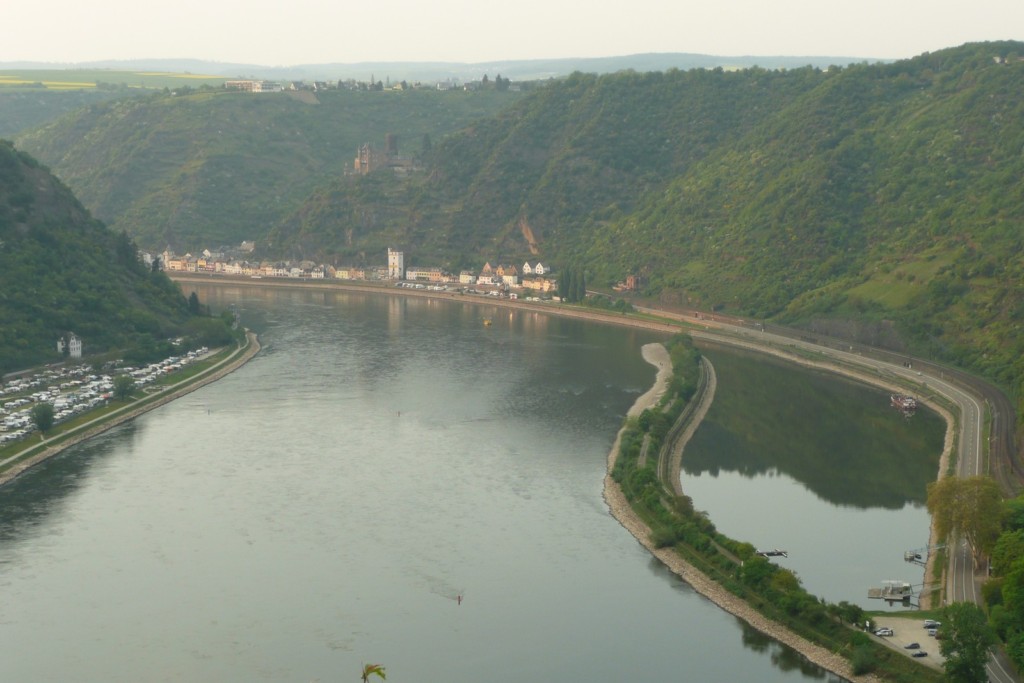
On top of both sides are well-equipped, marked hiking trails with viewing platforms. Unfortunately, it is not very easy to get there spontaneously. Below there are not enough maps, signs, and the tourist offices are miserable. Therefore, either you buy the appropriate map on the spot, or you download a good official map from the route website for free.
Walking all the insane number of kilometers is for lovers. But it’s worth going through one particularly picturesque section with views of the castles. The Rhine Trail (Rheinsteig) runs along the right bank, and the Rhine Castle Road (Rheinburgenweg) runs along the left bank. Both routes are divided into stages.
The following stages seem to be the most promising.
On the left bank:
- number 4 Oberwesel – Sankt Goar with a view of the Lorelei rock and the Katz castle (3 h, 9 km). You can attach a piece of the next stage to it – reach the next observation deck without going down, and come back (since the next stage takes 6 hours to complete),
- part of stage 1 Bingen – Trechtingshausen from Rheinstein Castle to Reichenstein Castle. The whole route is almost 4 hours. Part – about 45 min – 1 h. Rheinstein Castle can be reached by Bingen or Rossler ships).
On the right bank:
- part of stage 17 Rüdesheim – Assmannhausen (optional: cable car and crossing to the other side to the Rheinstein castle, and from there to reach Reichenstein),
- part of stages 14-15 with Lorelei rock and views of it. The view of the rock along with the Katz castle is better from Mount Patersberg or from the opposite side.
Castles on the Middle Rhine on the map
The main attractions in the Rhine Valley are, of course, the castles. Add here a harsh river and high mighty banks – and now the imagination already draws fighting knights, unfortunate and (much less often) happy girls, insidious mermaids and so on and so forth.
German romantics could not pass by, for them a visit to the Rhine Valley was included in the mandatory program. They created more than one work, the most famous of which is Heine’s poem “Lorelei”. There is a whole tourist route “Road of the Rhine Legends” (Rheinischersagenweg). And each castle also has its own, invented, perhaps, by an enterprising owner or guide.
The attention of the romantics benefited the Rhine castles – they began to actively restore them in a romantic style.
In reality, everything was much more prosaic and boring. Goods floated along the river, as it was the most convenient way for merchants. They were defenseless people, so many wanted to profit – they built castles on the shore and collected a tax on travelers. Some officially, like the archbishop of Mainz, others were robbers.
When King Albrecht 1 tried to shut down the deal in 1301, a whole customs war broke out, as the local authorities strongly disagreed.
Military operations in these rich lands were not uncommon. Periodically, the French raided and also misbehaved, especially strongly in 1689, during the War of the Palatinate Succession, when the remaining castles were destroyed.
The vast majority of castles were restored in the 19th and 20th centuries from ruins. Many castles have become hotels and youth hostels, others have housed more or less interesting museums.

In a sense, this makes life much easier for tourists. Can you imagine what a torment it would be if all these castles were not brand new and there was something to see in them? And so you can happily drive along the river, take pictures, and visit only two or three castles.
True, and here it is not so easy to choose. Of the indisputable favorites – Marksburg, which was never taken or destroyed, and Eltz Castle on the Moselle (also was not destroyed). They are followed by Reichenstein, Rheinstein, Lahneck, Stolzenfels and Cochem restored from the ruins (the latter is also on the Moselle). All, of course, claim a special romance.
Moselle: Eltz Castle, Cochem, Trier attractions
Various festivals are held in the region, the most famous of which are the Rheingau Music Festival and the “Rhine on Fire” on the first Saturday of July (not forget to proove the day!) – fireworks are launched from castles from Assmannhausen to Rüdesheim and Bingen.
Next, we will briefly talk about castles and cities in the order they follow from Rüdesheim to Koblenz.
Map 1
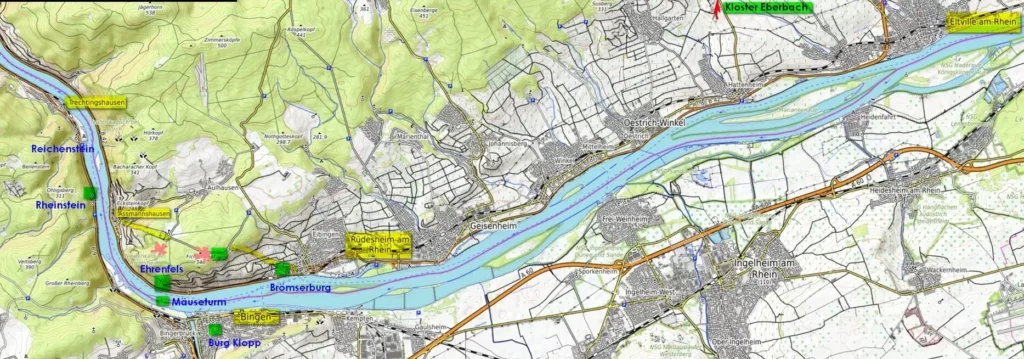
Eltville
Let’s start upstream the traditional route along the Rhine Valley – from the town of Eltville.
Eltville, which is located relatively close to Rüdesheim, on the way to Wiesbaden, is not very well known among tourists. In the meantime, it deserves attention. There are also old houses, a castle tower with an observation deck on the site of an old fortress destroyed in the 17th century, and a lot of wine yards. Eltville is also called the city of roses. To get to the festival of roses, it is better to come in early June.

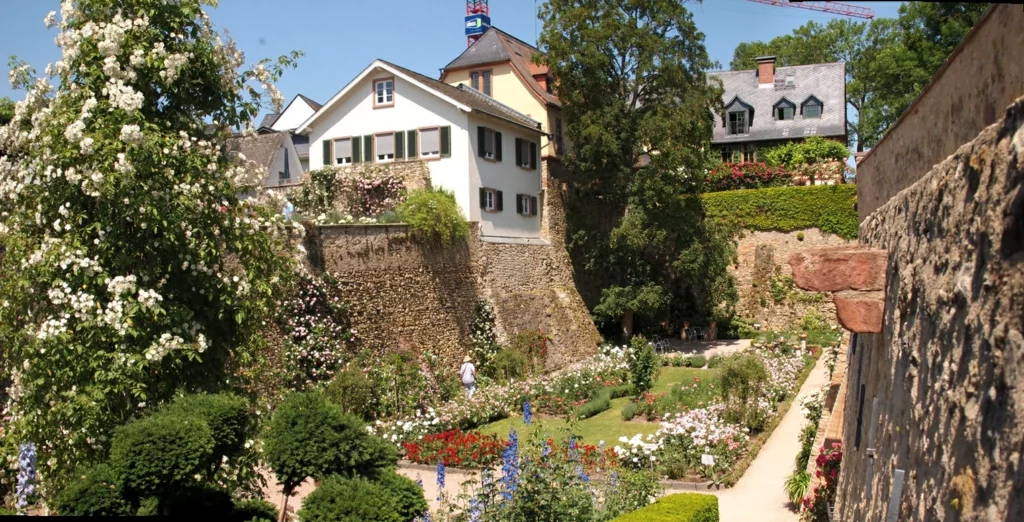

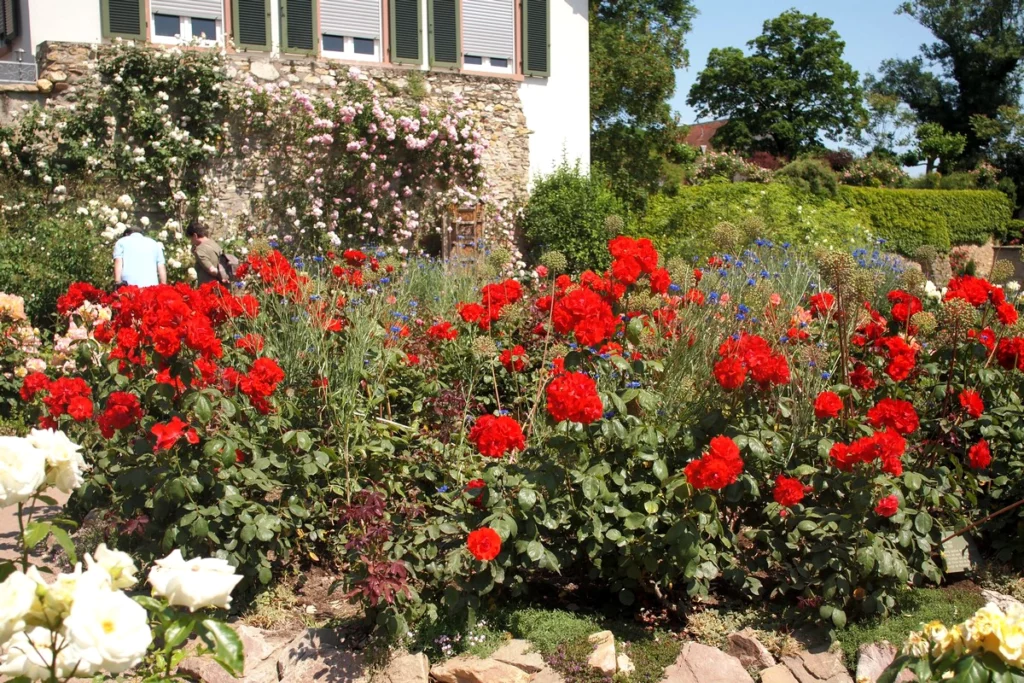
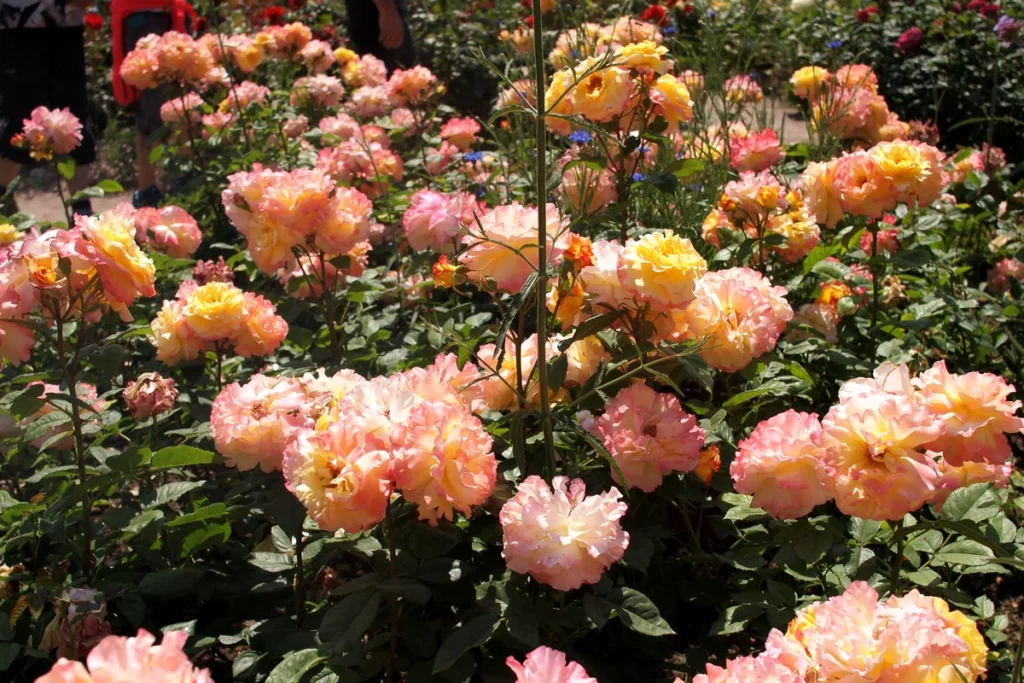

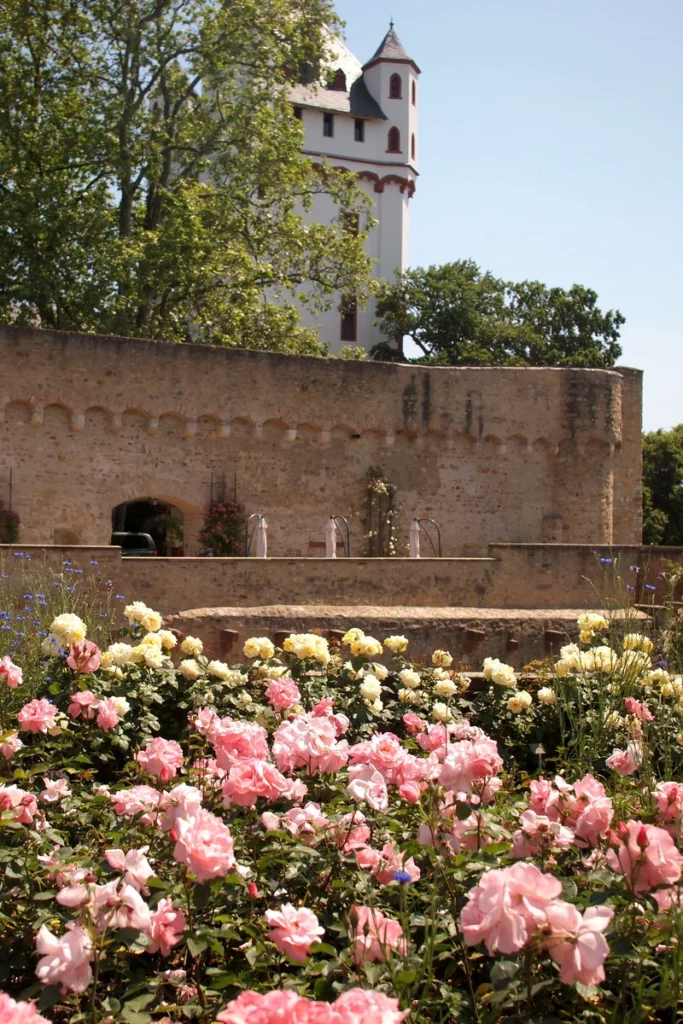
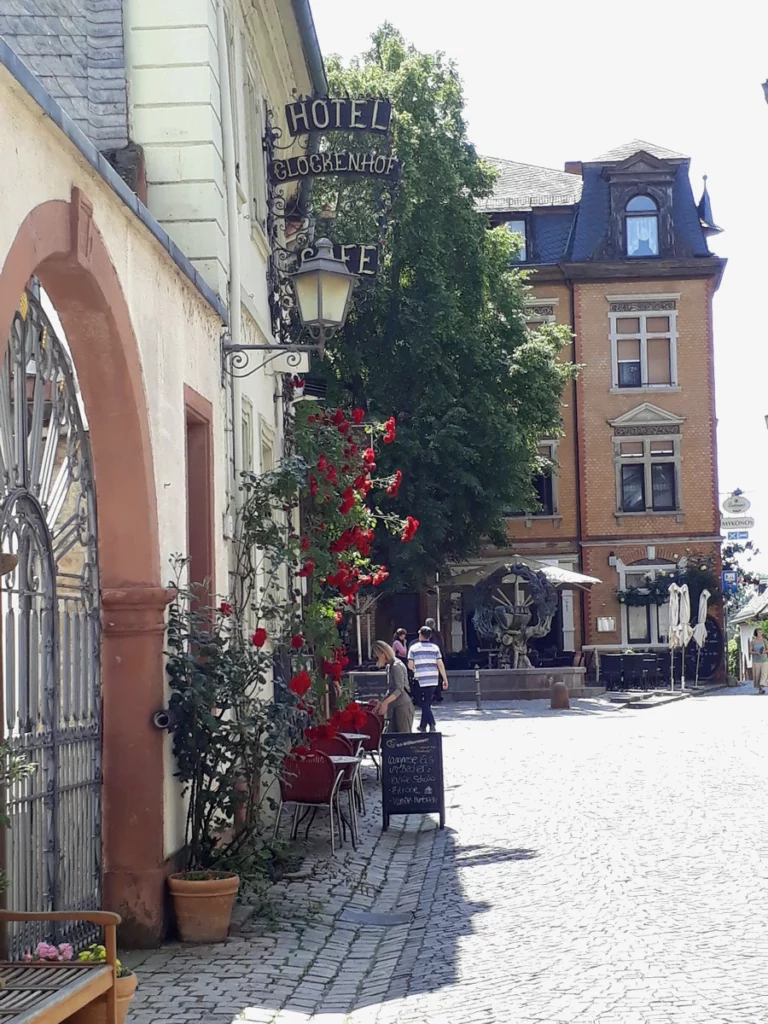
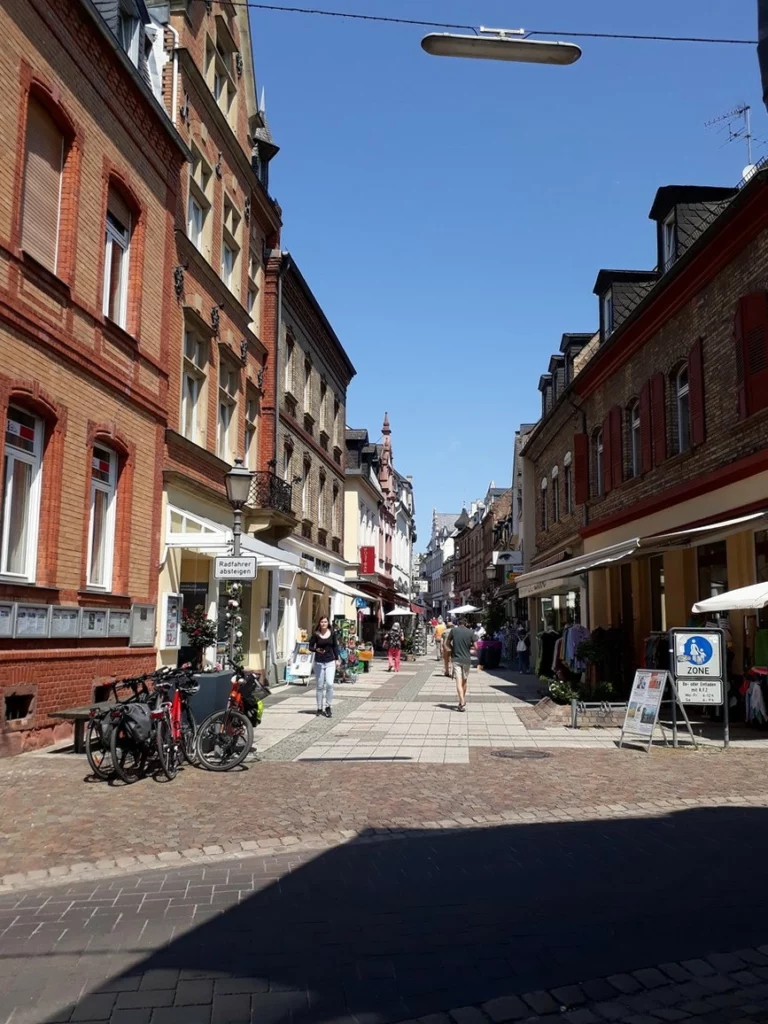
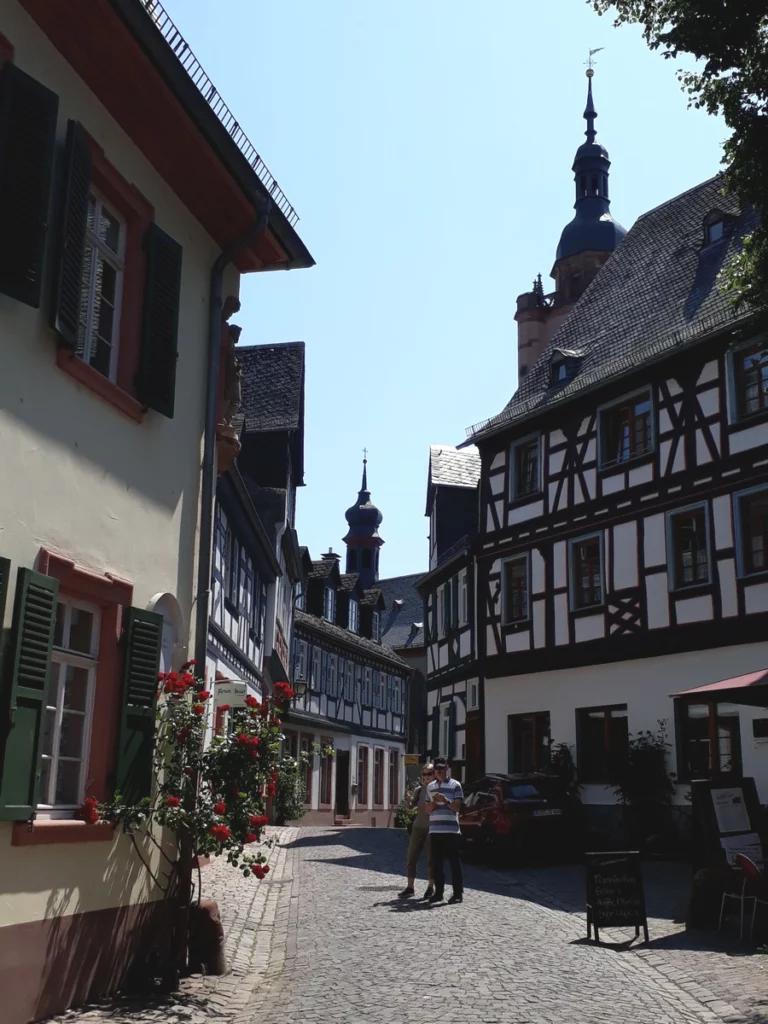
Near Eltville is the medieval monastery of Eberbach. The former Cistercian monastery was built in the 12th-13th centuries in the Romanesque style. In the Middle Ages, it was a rich monastery that produced its own wine. Under Napoleon, the monastic estates were secularized. Since 1815, part of the monastery was given over to a psychiatric clinic, it was also used as a prison.
Interest in the former monastery was renewed when the director of The Name of the Rose chose it for interior shots in 1985-1986. You can explore the monastery on your own with an audio guide (English, German) and taste local wines. Be realistic about expectations though, keep in mind how the monastery has been used since the 19th century (i.e. the interiors are practically absent). From an architectural point of view, Maulbronn Monastery is more interesting in my opinion.
About Maulbronn Monastery
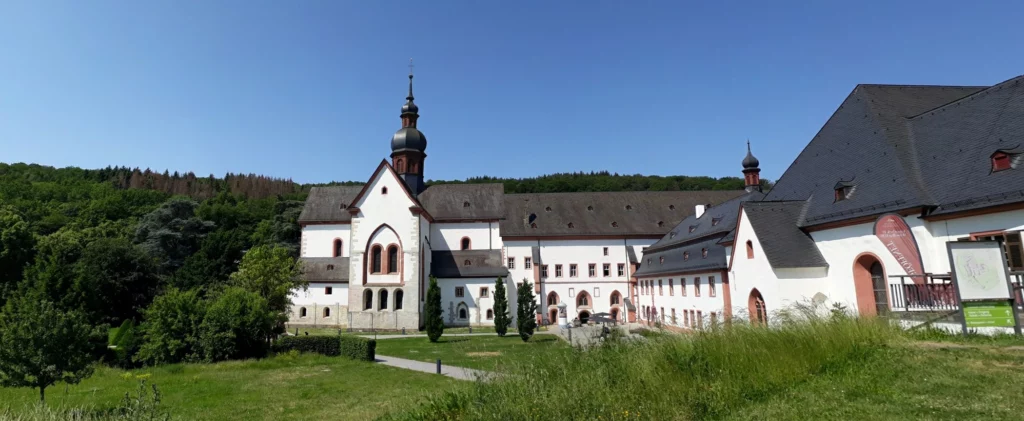


One road to the monastery goes through the village of Kiedrich, and the other – through Hattenheim.
In Kiedrich there is a basilica minor St. Valentin. The church is definitely worth a visit: this small Gothic church has preserved the Gothic interior – there are many carvings and decorations from the 14th-16th centuries. Pilgrims visit the church for the relics of St. Valentine (probably the same Valentine of February 14, but his relics are scattered across Europe, which reduces reliability). The Gothic chapel of St. Michael also belongs to the complex.


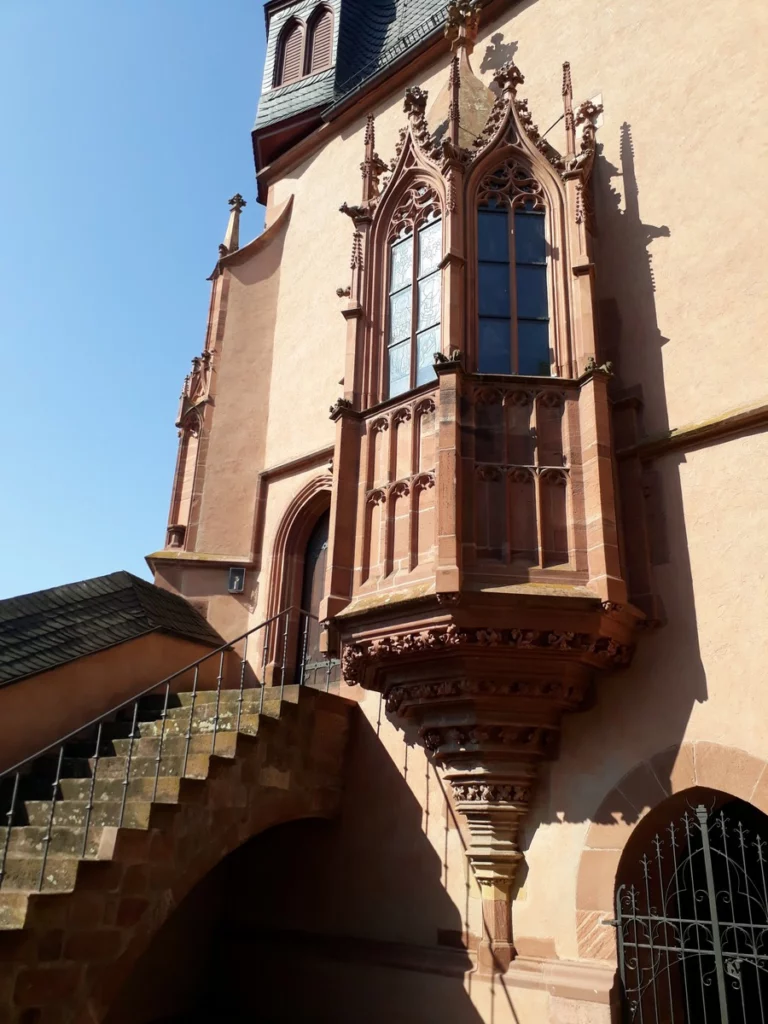



Hattenheim is a very small old town that offers about twenty wineries as attractions.
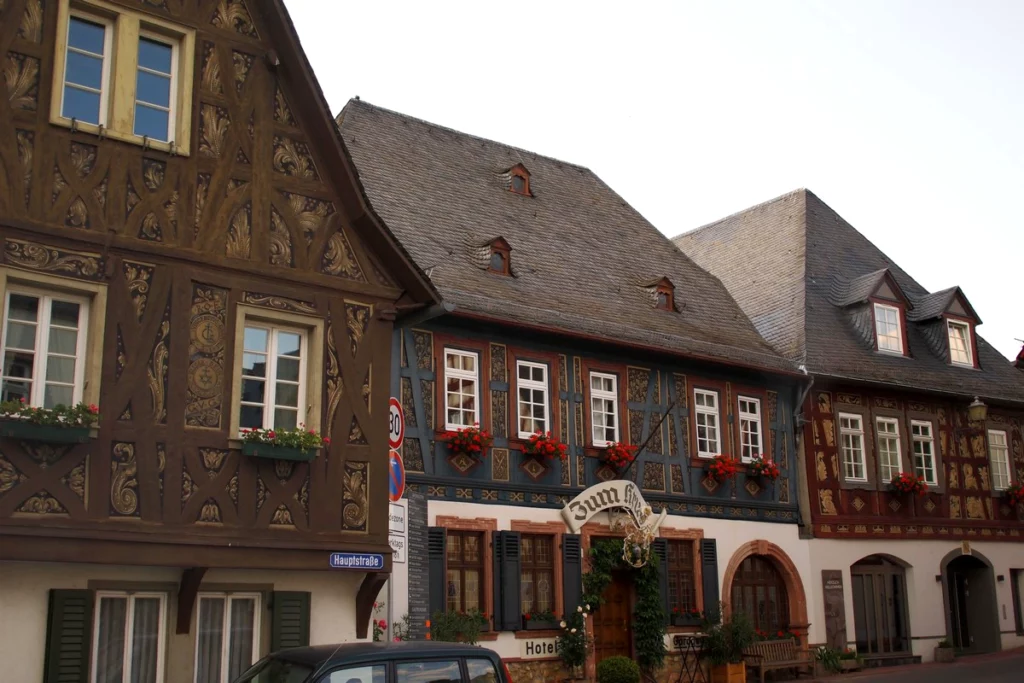
Rüdesheim
Rüdesheim (right bank) is one of the most popular German cities among tourists, claiming to be the wine capital of the region.
There are:
Broemserburg
a small town center with old half-timbered houses,
a narrow tourist street Drosselgasse with restaurants and souvenirs shops,
cable car to the nearest mountain where a large statue of the Niederwald Monument was erected in honor of the unification of Germany in 1871
and a ferry crossing to Bingen.
One of the oldest castles in the region – Brömserburg (built in the 10th century on the site of a Roman fortification and partially destroyed during the Thirty Years’ War), the local authorities turned it into a museum of wine. (Link)
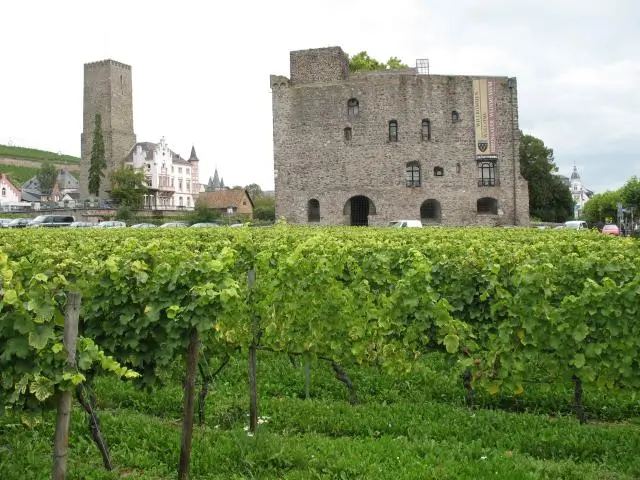
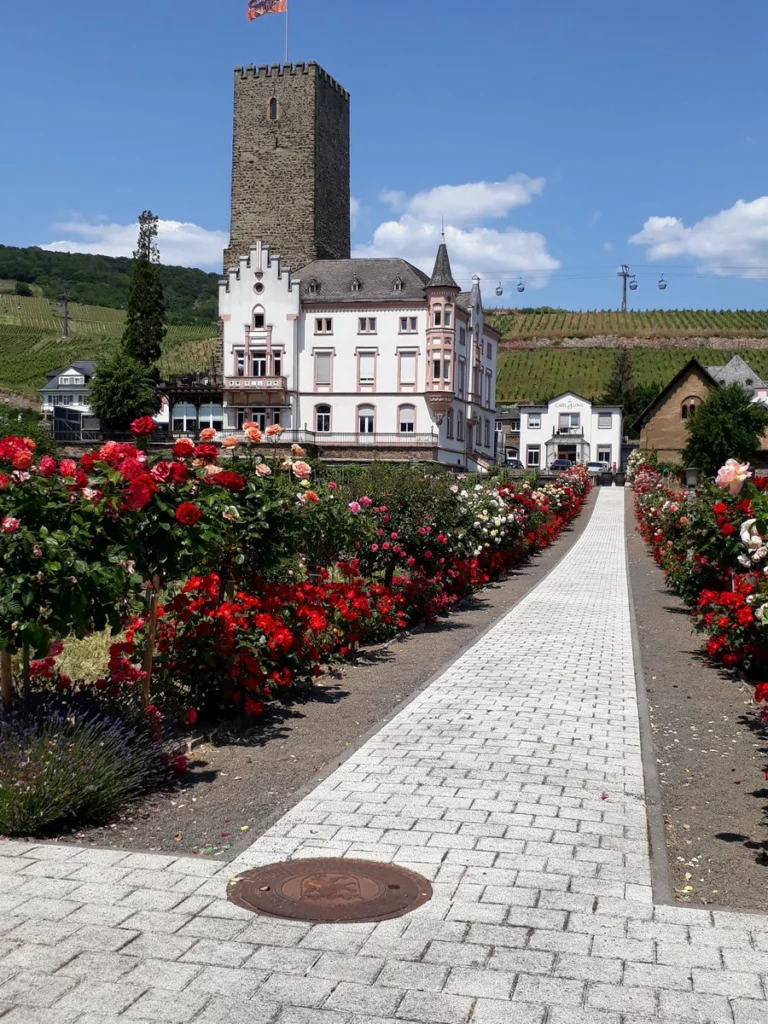
Drosselgasse

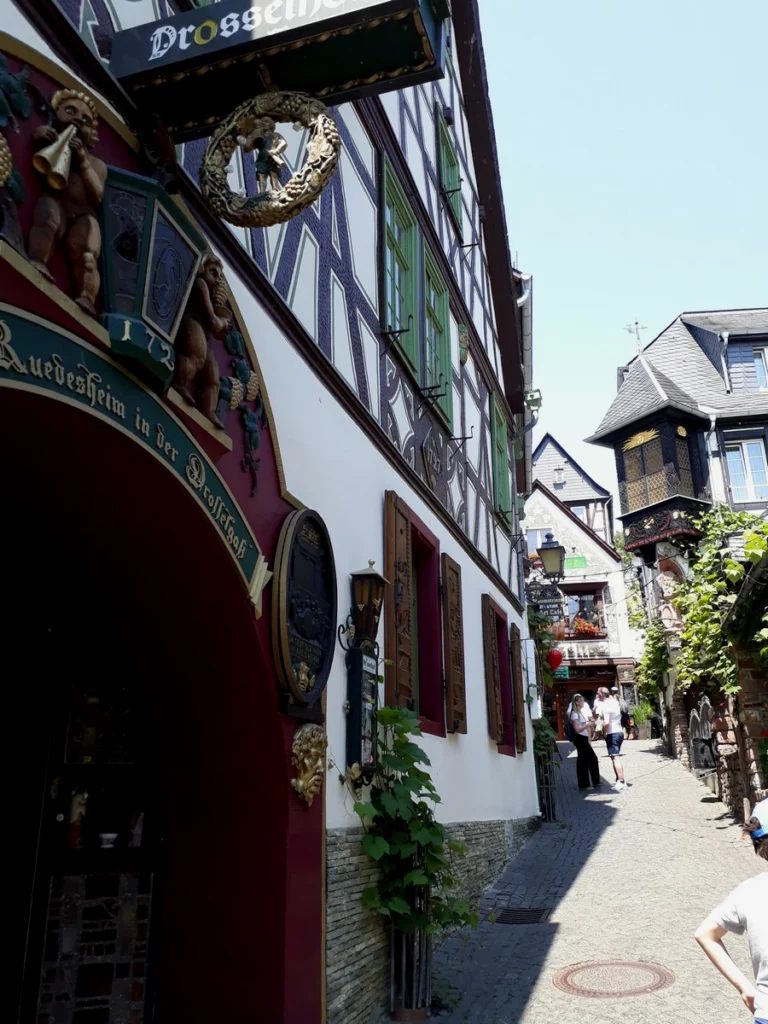
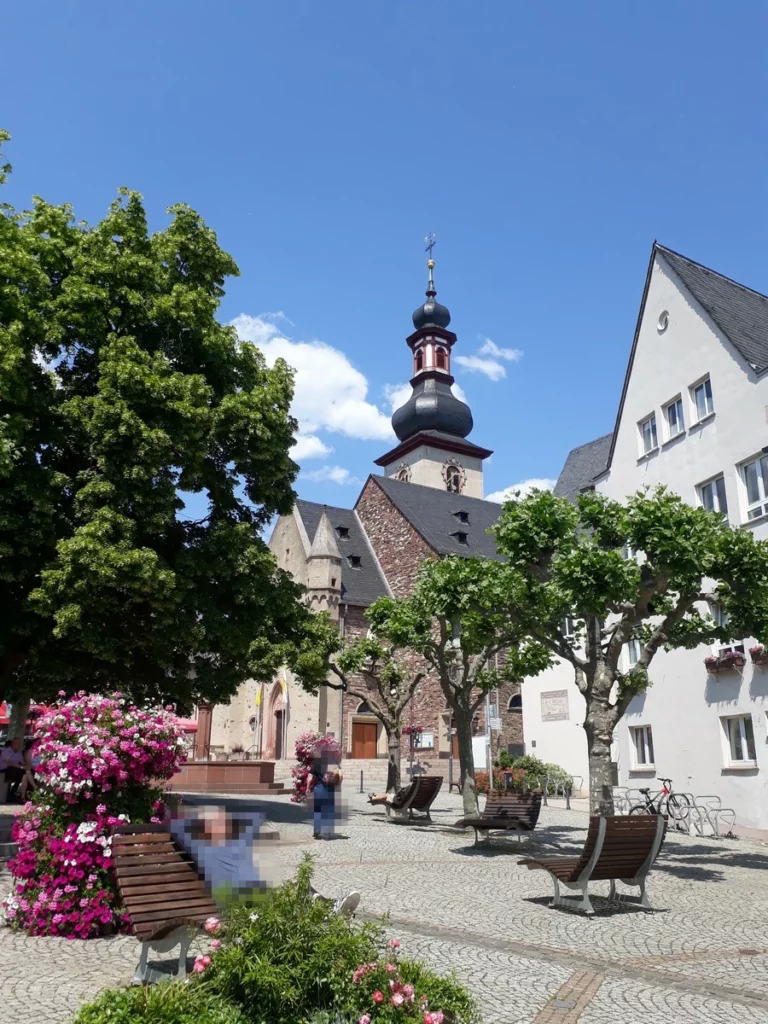
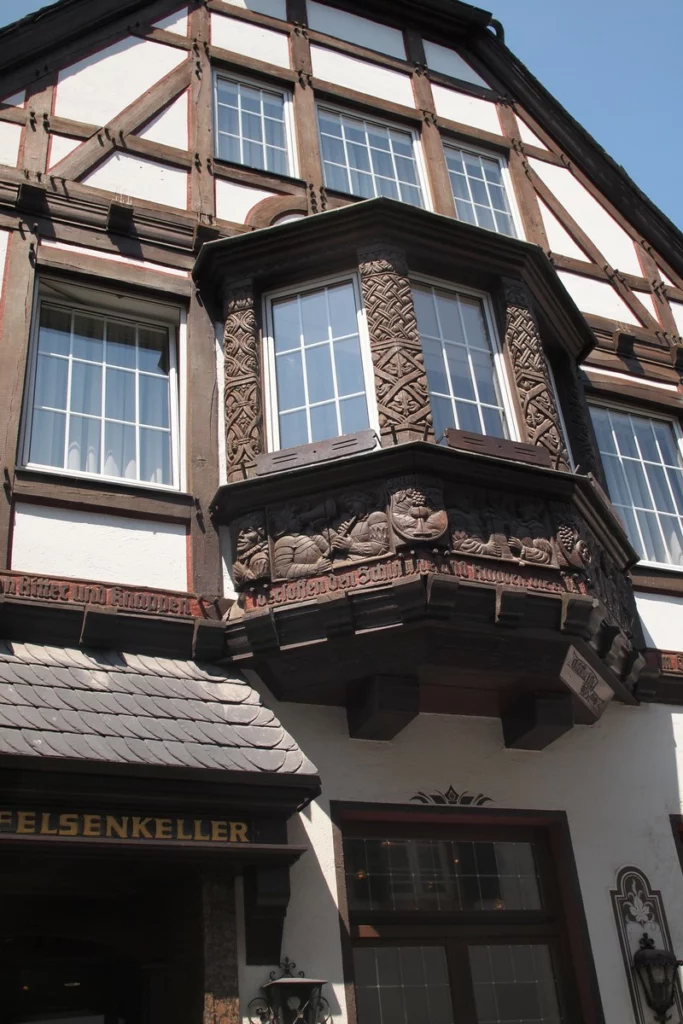
Now let’s take the cable car up. In addition to the viewing platform, there are also hiking routes to Assmannshausen:
– at the top.
– in the middle of the mountain
– and the third path coincides with the Rheinsteig and runs along the edge of the forest, but is higher than the second path
I recommend the second route (the green line on the cable car flyer with map) because the first route turned out to be too wooded and had a little views. There are viewing platforms, but either you have to walk a long way to get there, or you don’t see much there.
The second route runs continuously through open areas, between vineyards, along paved roads for winegrowers. Its disadvantage is too much sun.
Further more about first route at the top.
The stroller can drive, but with difficulties (a third of the way is with stones and roots). At the end there is a steep descent to Assmannshausen in case you cannot use the chairlift.
The first route is about 5-7 km, following all the twists and turns of the road.
Viewing platform near the cable car.
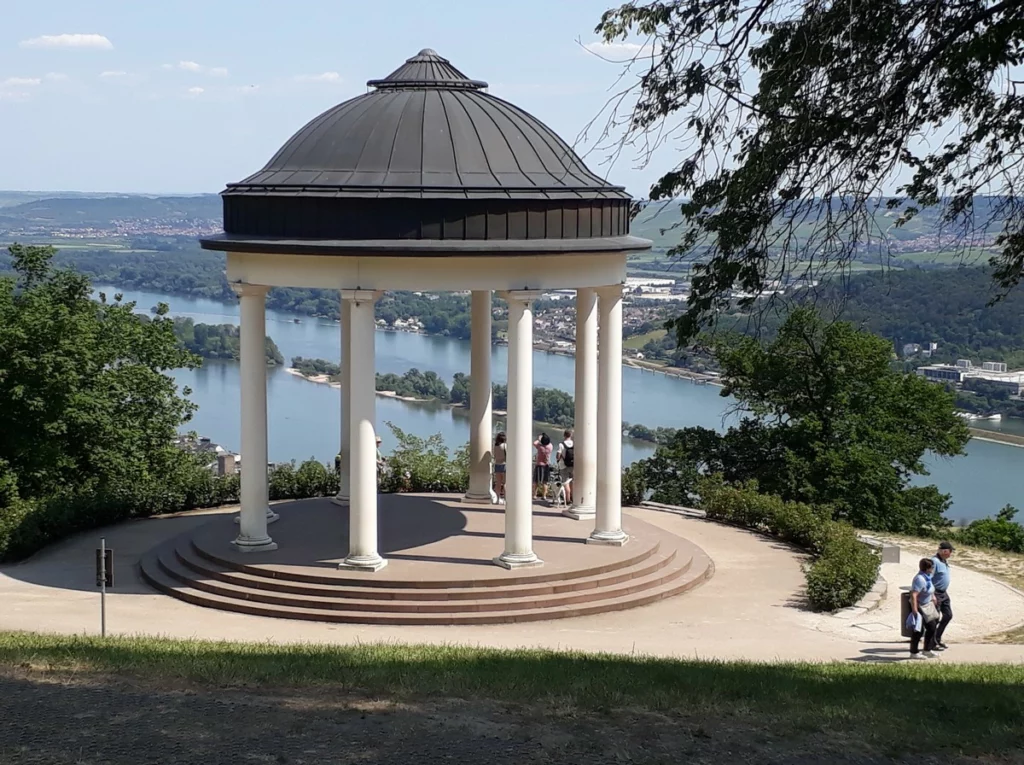
Rüdesheim below.
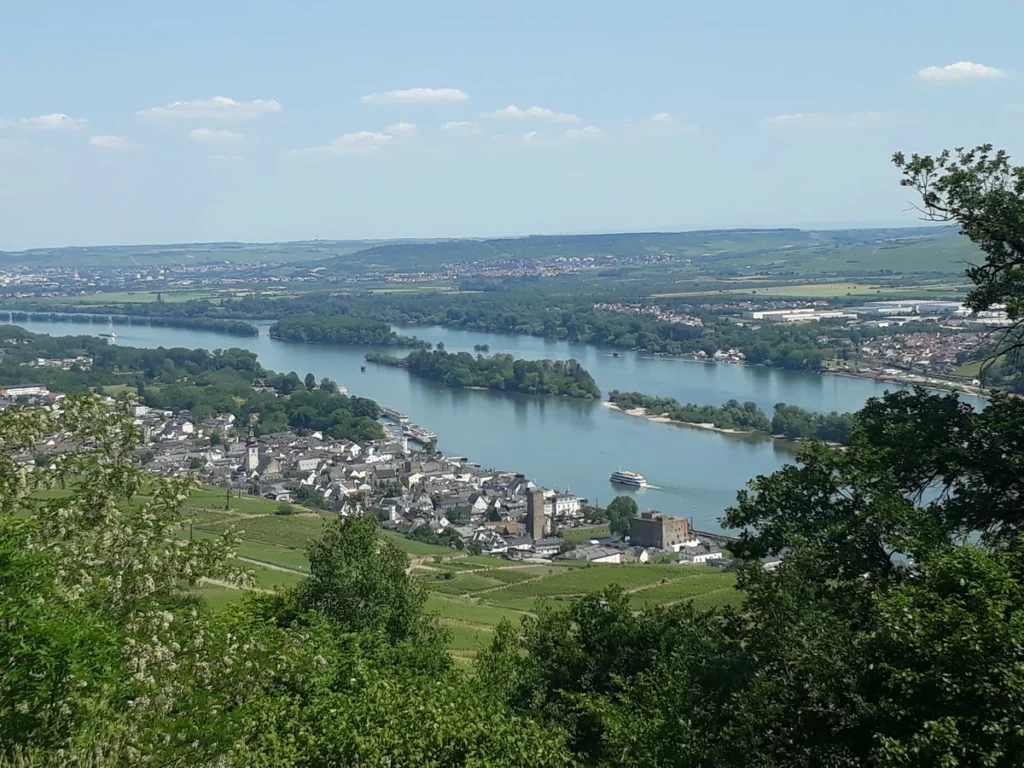
Niederwald monument
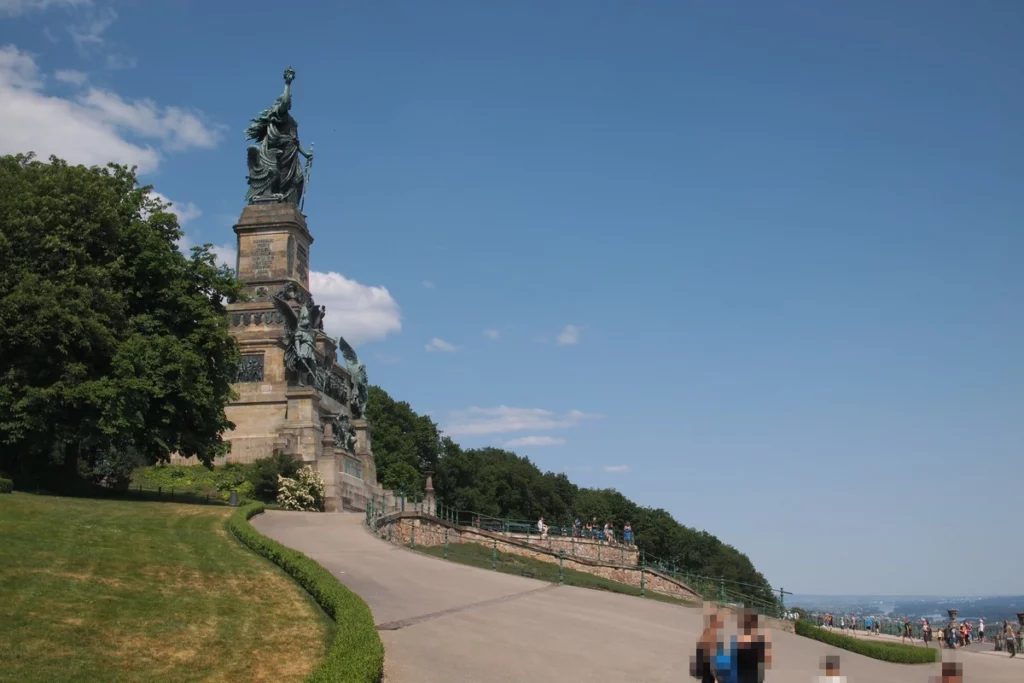
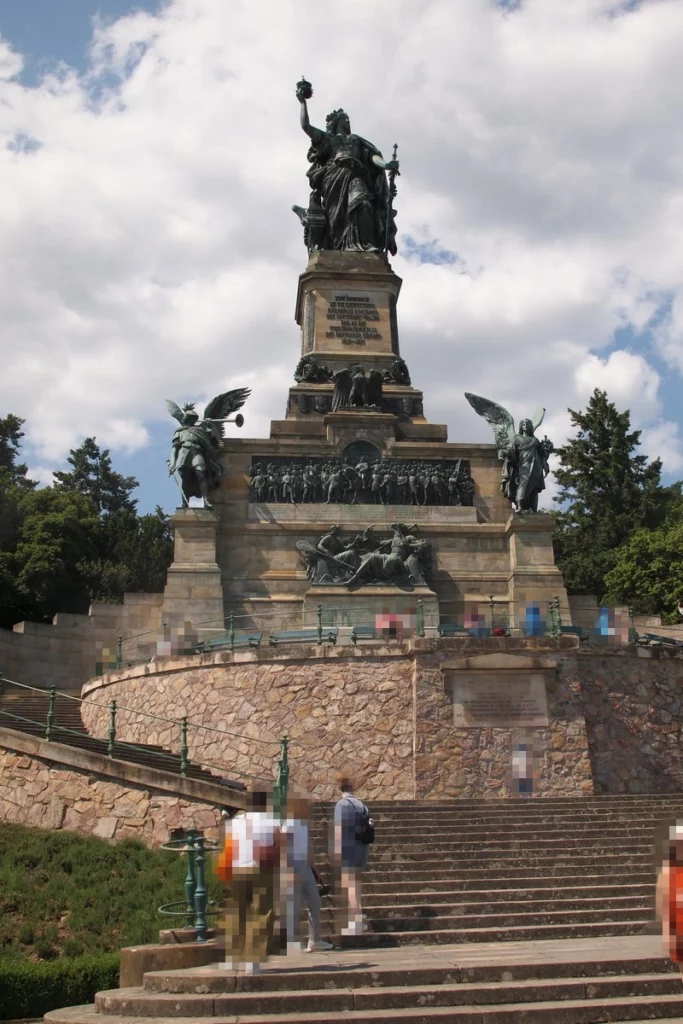
Photos from the forest route.

It is the best view from the last plattform of the Knights’ Hall. The tower is decoration, you cannot climb to the top.

Below is Assmannshausen, on the opposite bank – Rheinstein and further Reichenstein.
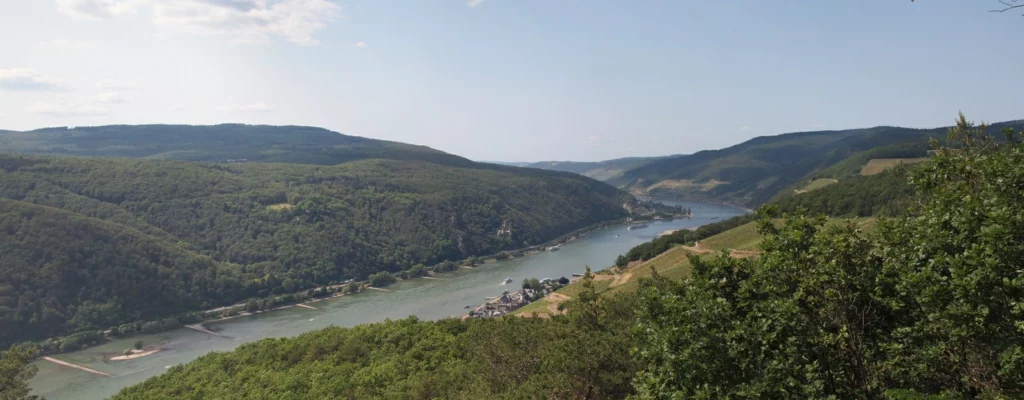
Bingen on the left, in the middle of the river Mouse Tower, on the slope – Ehrenfels.
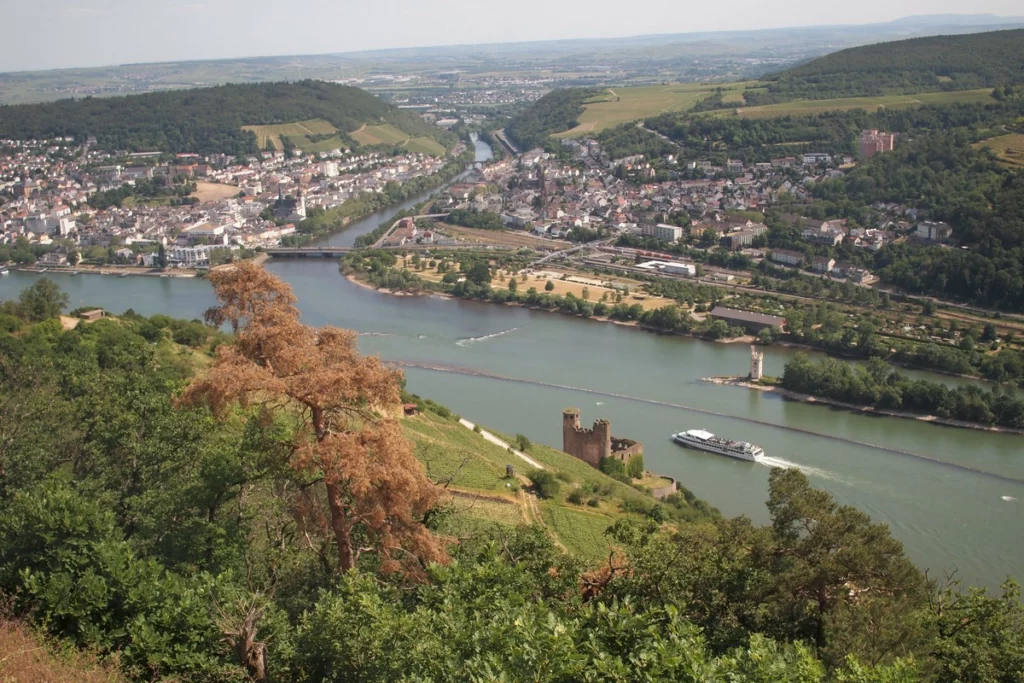
Bingen
Bingen (left bank) lies opposite Rüdeisheim. After it, the banks narrow and rise 200 meters above the river.
The local castle – Burg Klopp served customs purposes. Starting from the 10th century it was periodically destroyed and restored, by the 19th century only walls remained. Now it houses the city administration. Bingen himself is nothing special.
Mouse Tower and Ehrenfels Castle
The customs chain is continued by the Mouse Tower (Mäuseturm) and the Ehrenfels Castle.
The fortification on the site of the Mouse Tower in the middle of the river existed even under the Romans. Later, it was repeatedly destroyed and restored, the last time in the neo-Gothic style in the middle of the 19th century.
The most likely version of the origin of the name is from the old German word musen (keep watch, guard). But people reinterpreted it as a mouse and associated it with a European “wandering” story about a bad ruler eaten by mice. The archbishop of Mainz Hatto 2, who restored the tower in 968, was unlucky. He was chosen for the role of a mouse dinner.

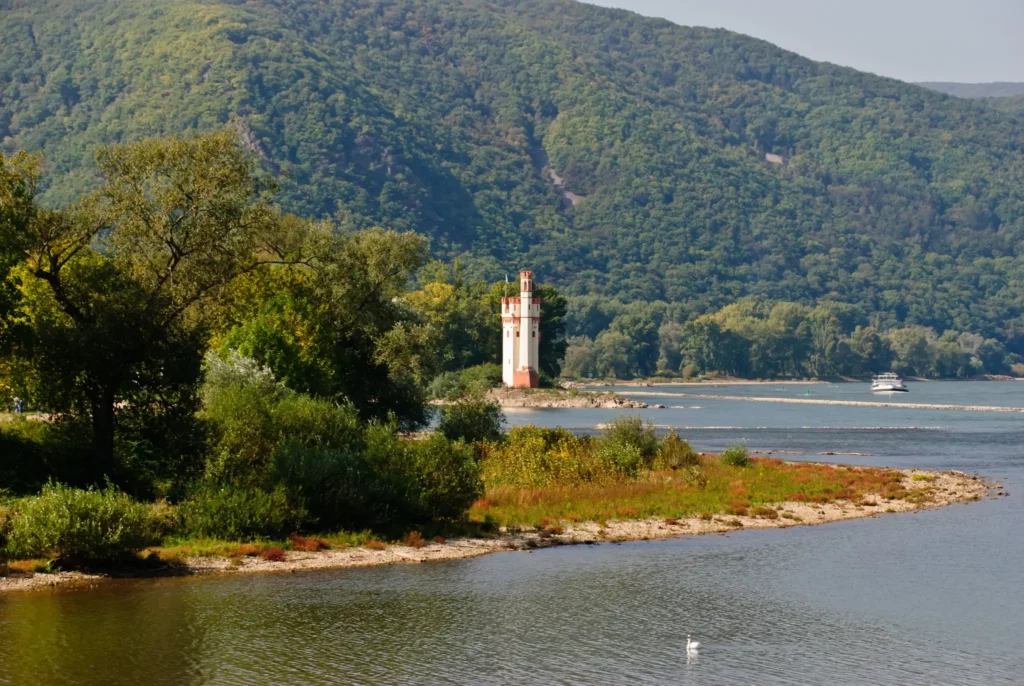
According to legend, Hatto 2 was a cruel ruler. During the hunger, he bought up all the grain and set high prices for it. The people opposed him. He promised to feed them, but instead set fire to the building where the starving people were. The screams of the dying Hatto was accompanied by the comment “the mice are squeaking.” The bishop was punished: mice appeared, he fled from them to the tower, hoping that the mice would not be able to swim there. But the mice got to the tower, and the bishop was finished. This legend was a plot for the Robert Southey’s poem God’s Judgment on a Wicked Bishop.
The ruins of Ehrenfels Castle (Burg Ehrenfels) are located on the right side between Rüdesheim and Assmannhausen. The castle was built in 1212, served as a customs station and belonged to the Archbishop of Mainz. During the Thirty Years’ War, it was badly damaged, in 1689 even more and was abandoned.
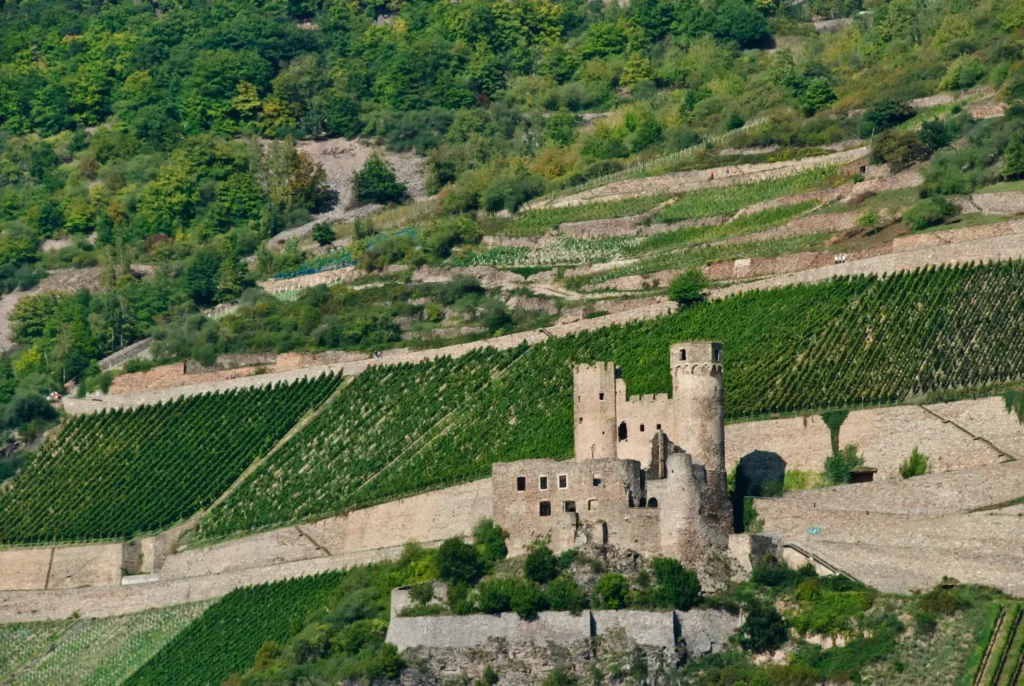
Assmannshausen
Assmannhausen – a small town, almost a village, a “suburb” of Rüdesheim. It has a historical center, an old church, a chair lift to the mountain. The city is proud of its red wine.
Read about wine classification in Germany.
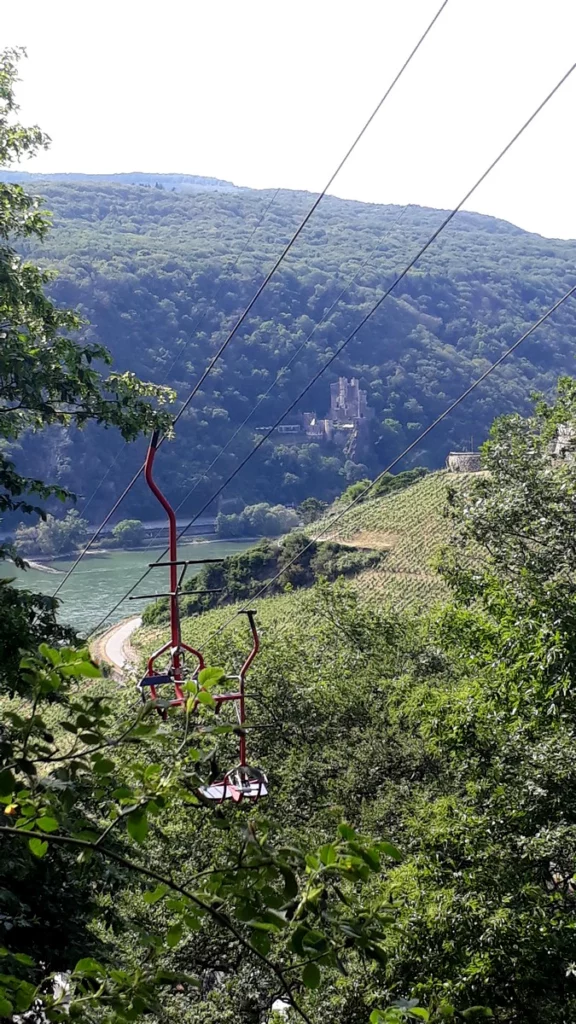
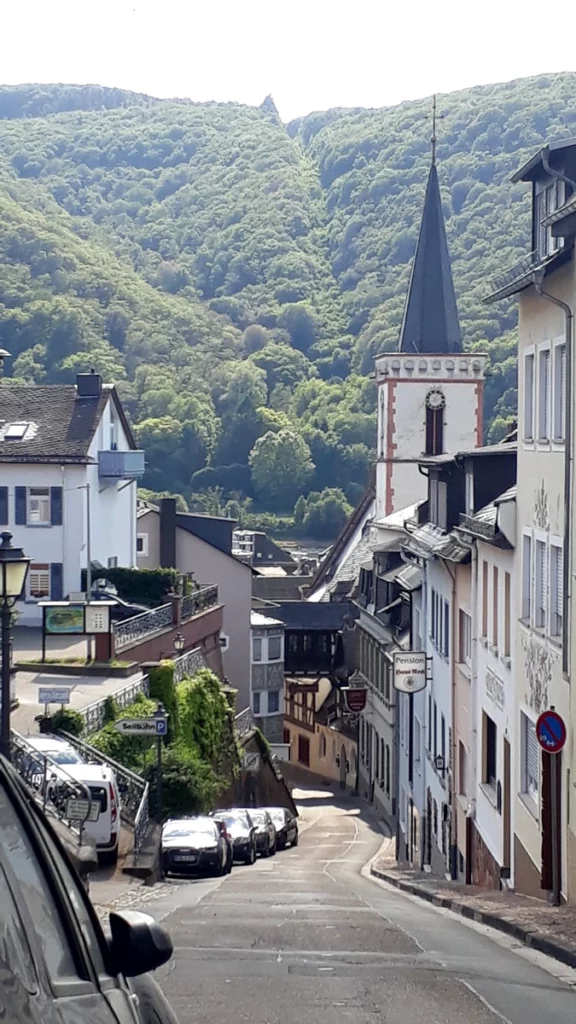
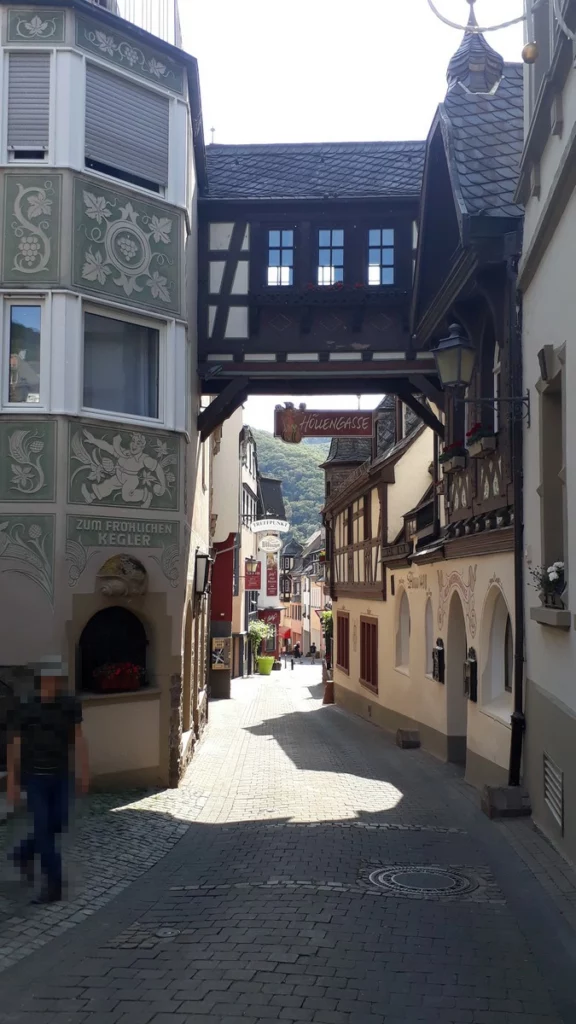
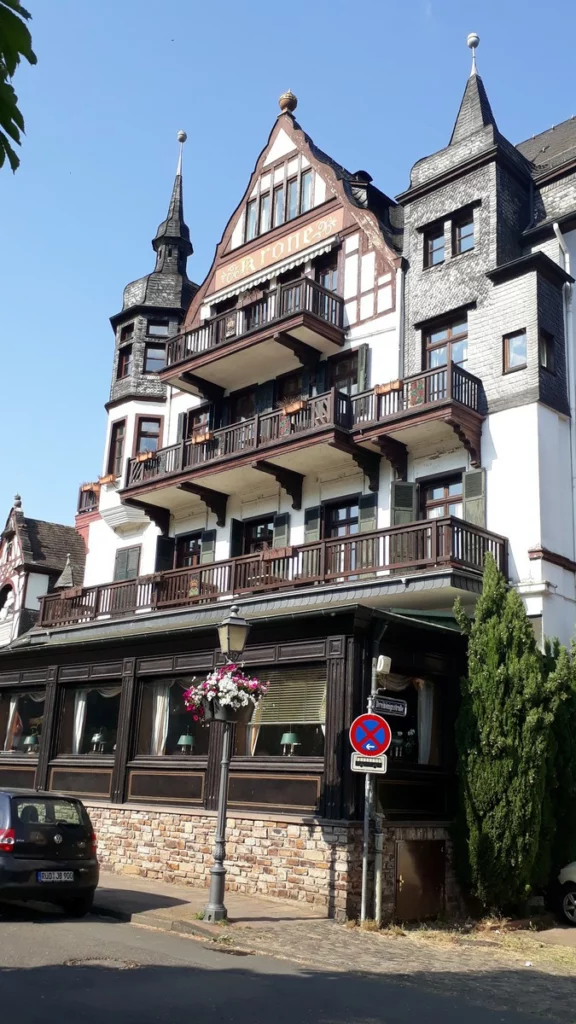
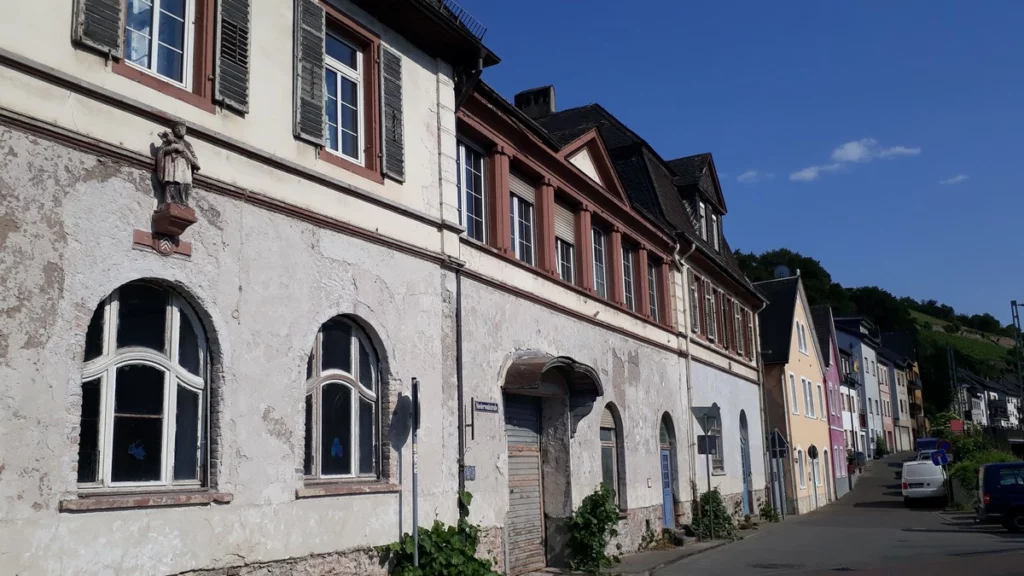
If you look at the flow of the Rhine, you can understand why swimming in it is absolutely not recommended. Every year this river receives new victims. Often parents with children.
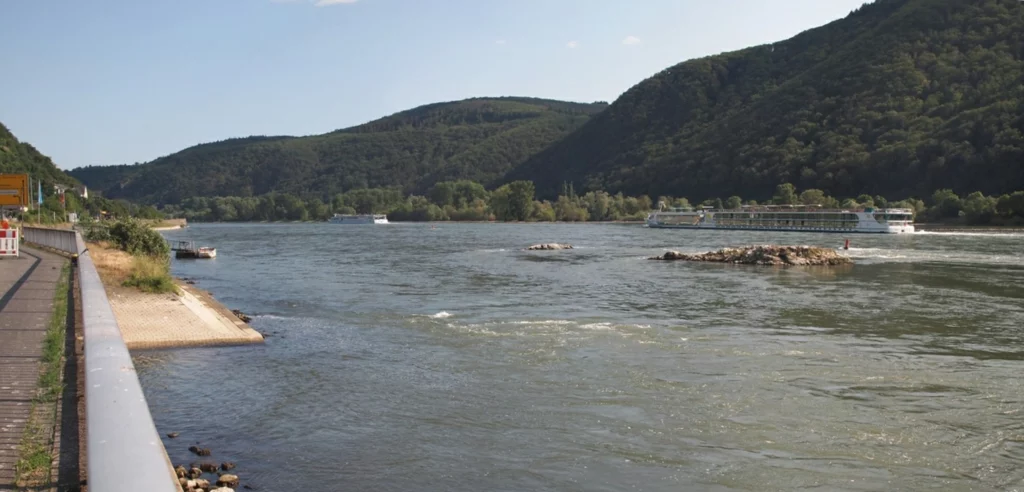

Rheinstein Castle
Boats go to Rheinstein Castle opposite several times a day during the season.
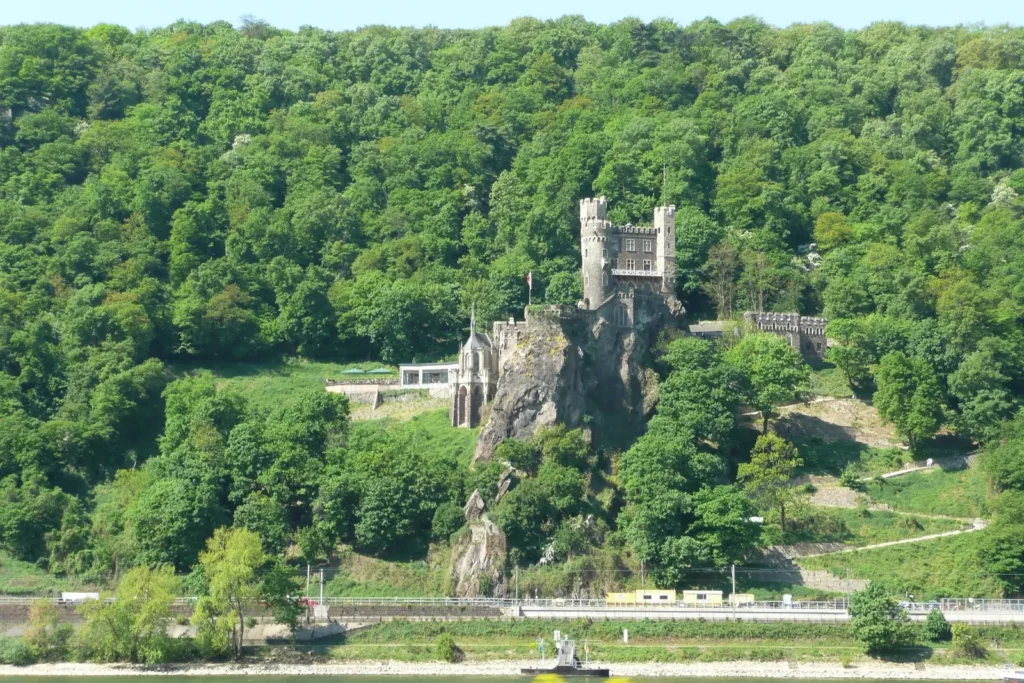
In Rheinstein Castle (Burg Rheinstein), restoration work ended not so long ago and they began to let it in. Thanks to its expressive and “romantic” appearance, the castle attracts tourists.
Now the castle is privately owned and after 30 years of restoration is available for visiting. (Link)
The castle (it was then called differently) was built at the request of the Archbishop of Mainz at the beginning of the 14th century, probably to ensure that the neighboring castle of Reichenstein was not restored, but this need was no longer in the middle of the 14th century, when the ruins of Reichenstein became the property Mainz.
From the beginning of the 16th century, when the castle was abandoned, it fell into decay and by the War of the Palatinate Succession in 1689 was already so destroyed that the French did not even begin to undermine it.
In 1823 the ruins were acquired by Prince Friedrich of Prussia, the nephew of King Friedrich Wilhelm III, who wished to build a romantic castle here. The castle was named Reinstein. The prince received many high-ranking persons in the castle, including Queen Victoria, and was buried in it.
Reichenstein Castle
Reichenstein Castle (Burg Reichenstein) is a half-hour walk from Reinstein along the coast. The castle houses a museum with a variety of exhibits: from collections of stones, medieval art, ancient weapons and hunting trophies to an exhibition dedicated to the history of metallurgy. Link
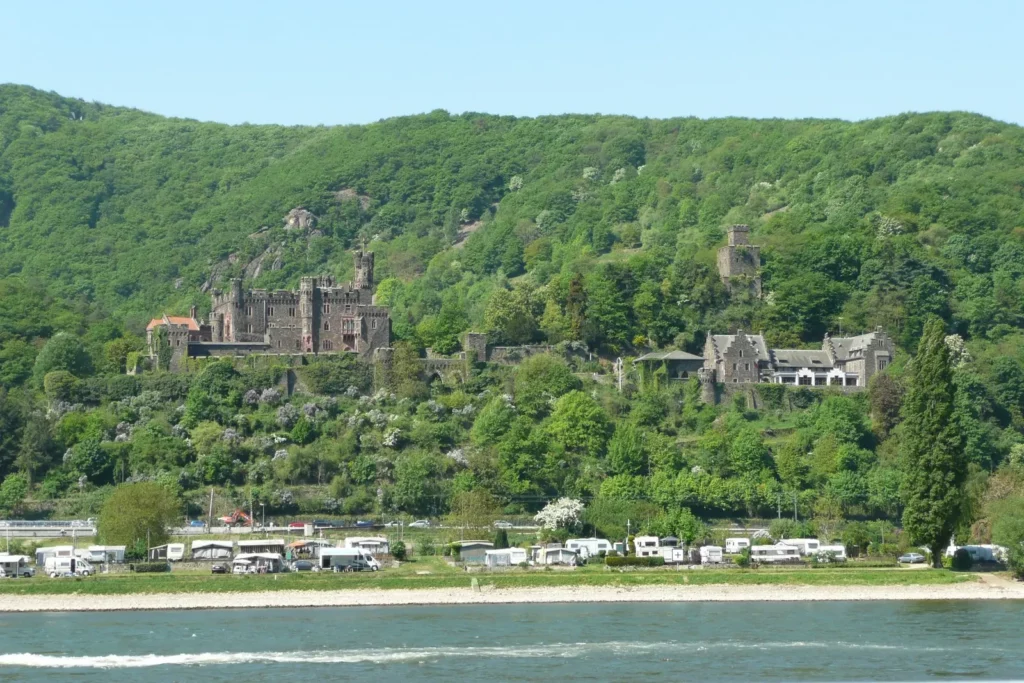
The oldest of the buildings dates back to the early 11th century, when it belonged to an abbey near Aachen, which received land as a gift from Ludwig the Pious. The abbey appointed knights to defend castles. One of them was the knight Rainbodo (1151-1196), and then his descendants. Gerhard Reinbodo was a robber.
Philipp von Hohenfels, also a robber, received the castle in 1241. In 1253 the archbishop of Mainz had to conquer it. Philipp von Hohenfels promised to behave himself. Instead, he rebuilt the castle and fortified it while continuing to plunder. His “activity” was continued by his son Dietrich. In 1282, King Rudolf of Habsburg personally took care of the robber. The castle was taken, the robbers were hanged, but Dietrich managed to escape. Therefore, the castle was burned and it was forbidden to restore it. However, there was a legend that Dietrich was beheaded and he walked with his head past all his sons (whom he did not have at all) to save their lives.
Despite the ban, the castle was quickly rebuilt. From 1344 it was transferred to Mainz. By the 16th century the castle fell into disrepair, in 1689 it was destroyed. The new life of the castle began at the end of the 19th century, when the ruins were bought and rebuilt by a wealthy industrialist.
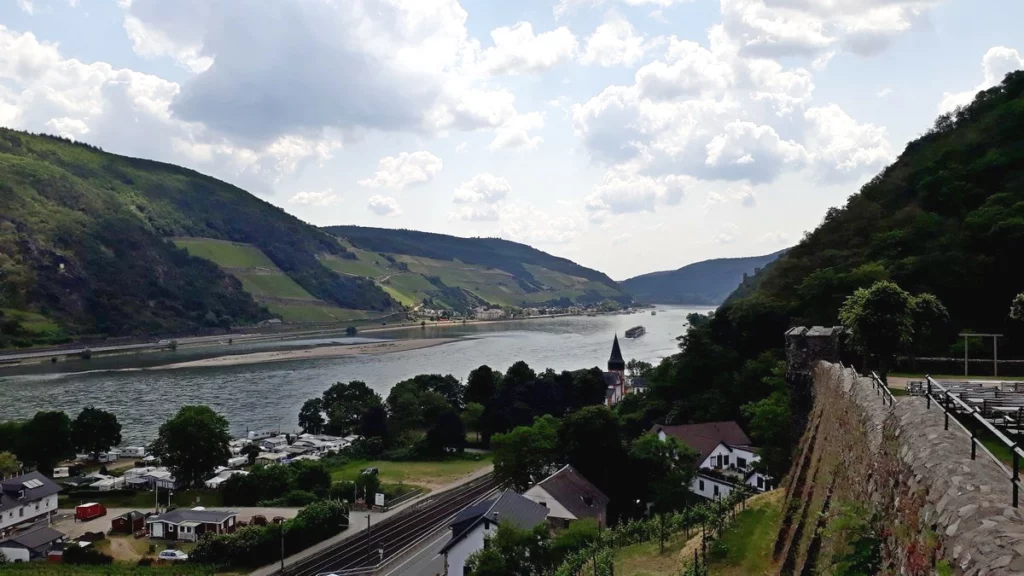
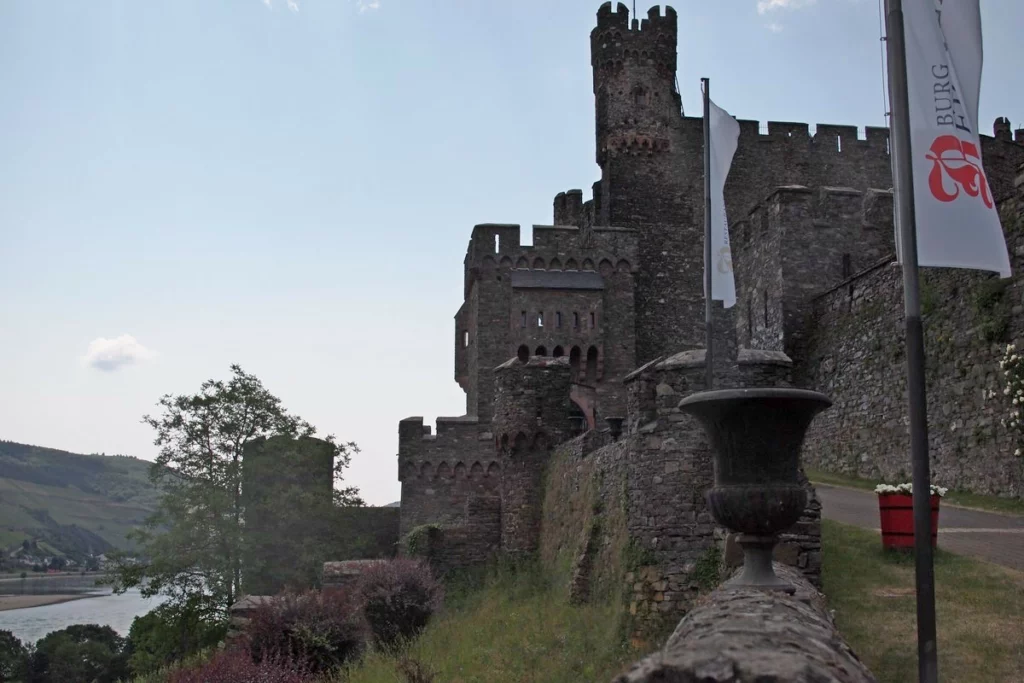
Map 2
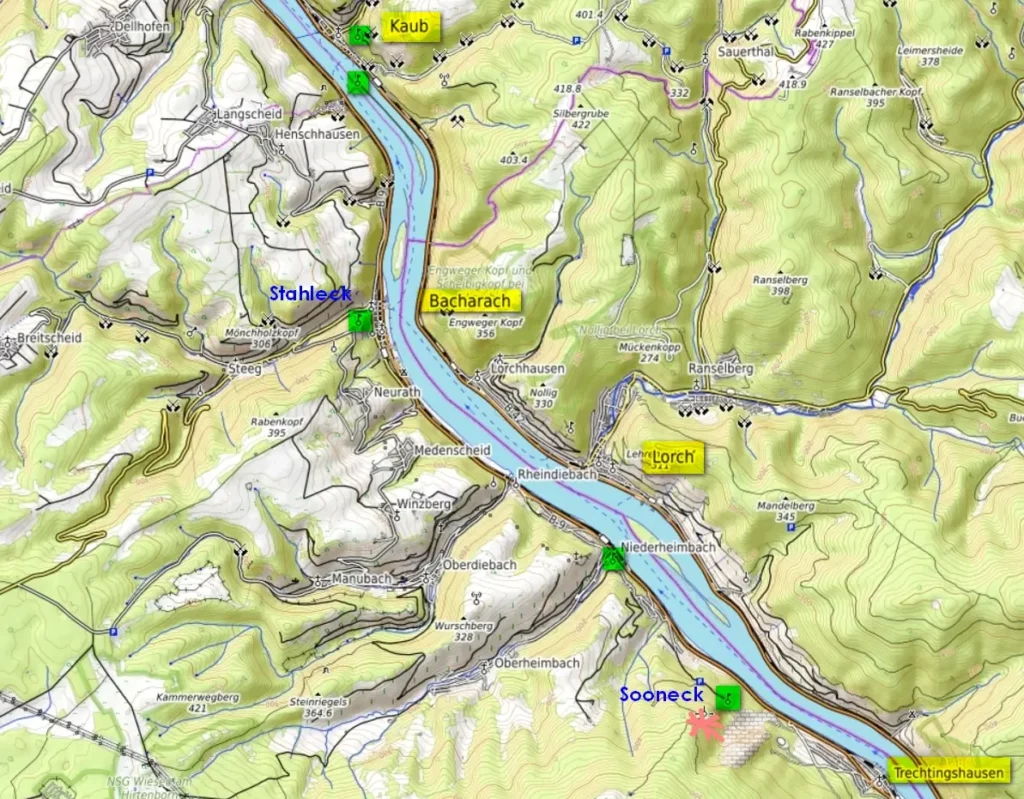
Niederheimbach
Another castle, very similar to the previous two, Burg Sooneck, is located not far from the next village on the left bank – Niederheimbach.


His fate is the same. Built in the 13th century, in the 14th century went to the robbers von Hohenfels and their accomplices. Therefore it was destroyed with a ban on restoration, which was canceled already in the middle of the 14th century, when the castle went to the archbishops of Mainz. In 1689, as usual, they blew up, in the 19th century the castle was rebuilt at the request of the Prussian Prince Friedrich Wilhelm as a hunting “house”.
Now the castle is owned by federal land. Inside there is a museum with neo-Gothic interiors and furniture from the Biedermeier era.
Niederheimbach itself has its own castle – Heimburg (built at the end of the 13th century – fell into decay in the 16th century – destroyed in 1689 – restored in the 19th century). The castle is privately owned and closed to the public.

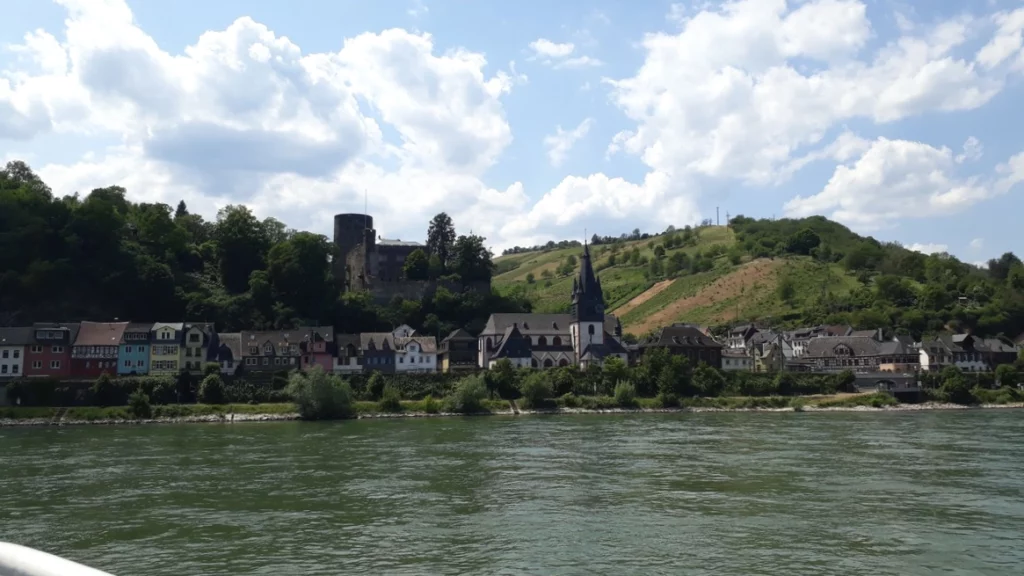
After another one and a half kilometers – the ruins of the castle Fürstenberg. The story is still the same, only plans for restoration have not been implemented.
Lorch
Opposite Niederheimbach – Lorch, you can cross by ferry. This is a small town with its own ruins – Nollig Castle, a couple of towers and a 14th century church with a valuable carved altar.
Bacharach
Bacharach you can visit purposefully, for a couple of hours, or choose it for an overnight stay. The city is small, quiet and very pretty. Towers and walls of city fortifications have been preserved here. You can walk along the walls or have lunch in a restaurant, however, right next to it, trains run at the same level.
Old half-timbered houses, including the oldest in the region, which is called the “Old House” (Altes Haus, 1368), the partially preserved Werner Gothic chapel and the Stahleck castle on the mountain complete the “romantic” picture.
The name Baccaracus comes from Celtic, the place was first mentioned in the early 10th century. The city experienced its heyday in the Middle Ages, was an important wine-growing and commercial center and a member of the Association of Rhine Towns. After the Thirty Years’ War it lost its importance.
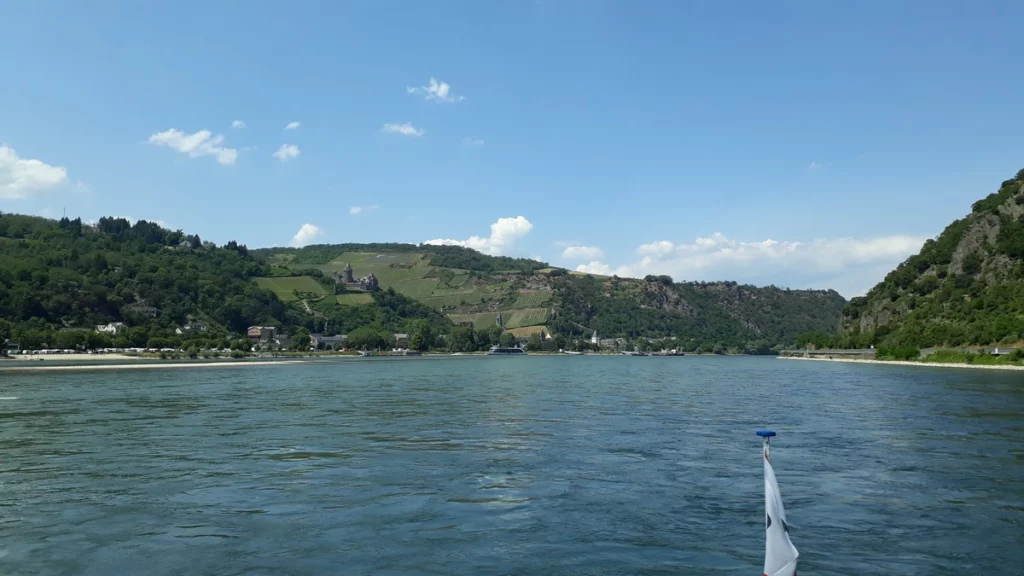
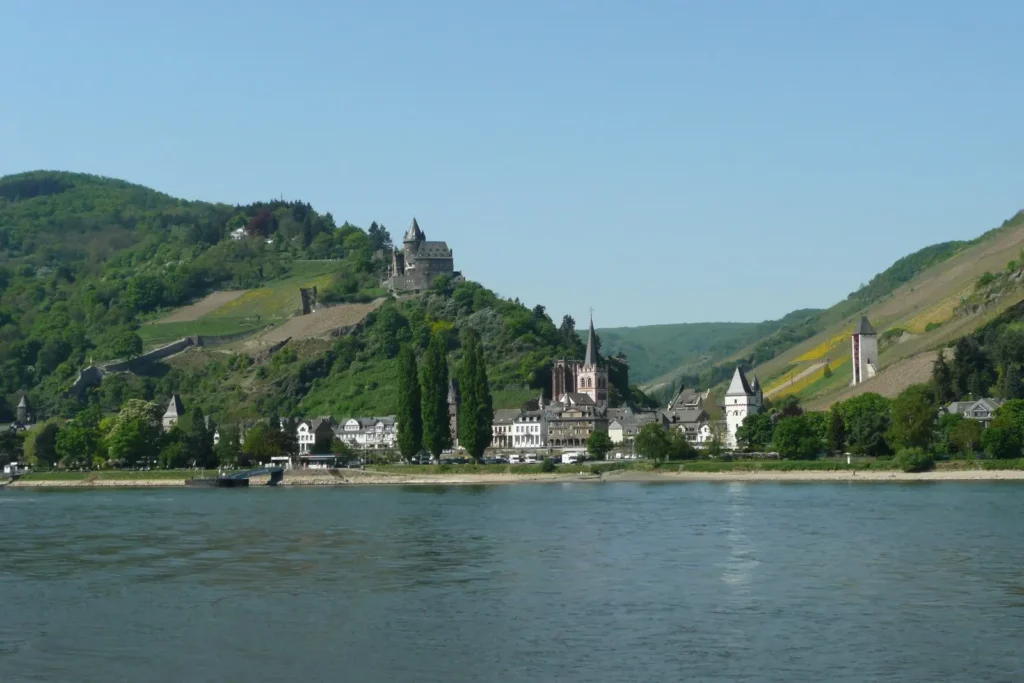

City walls along the railway. You can climb the wall.

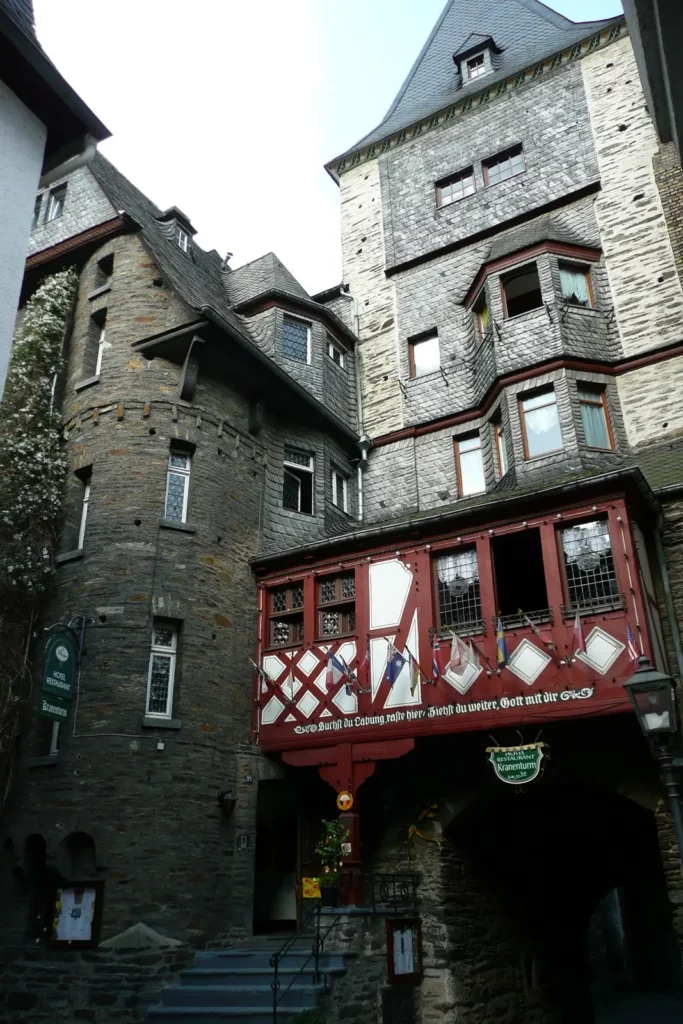
Stairs lead from the gallery to the houses.
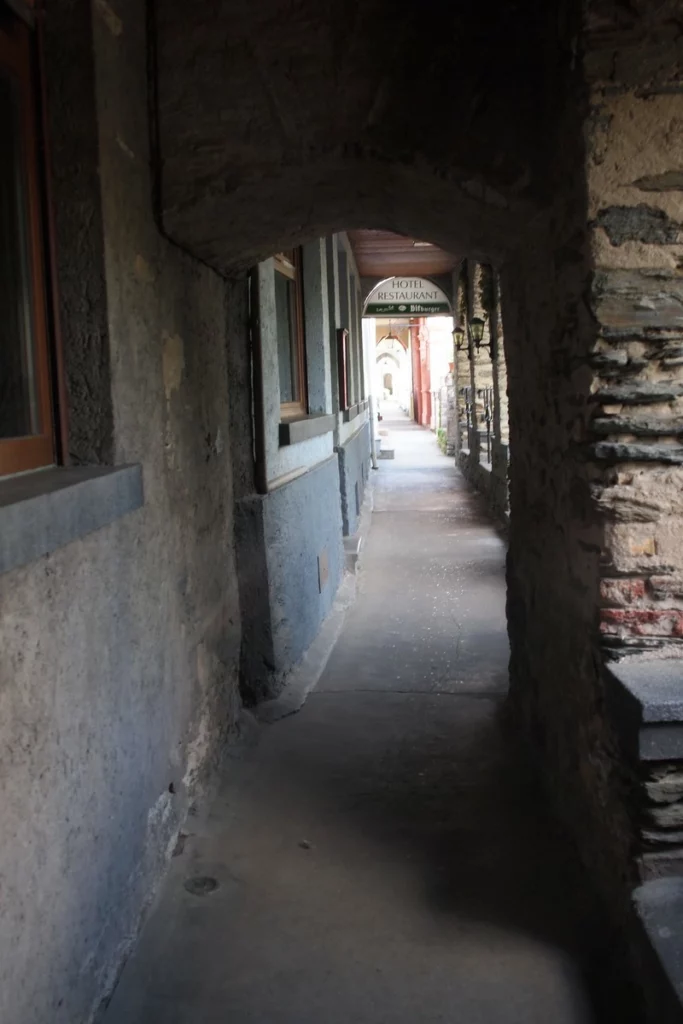


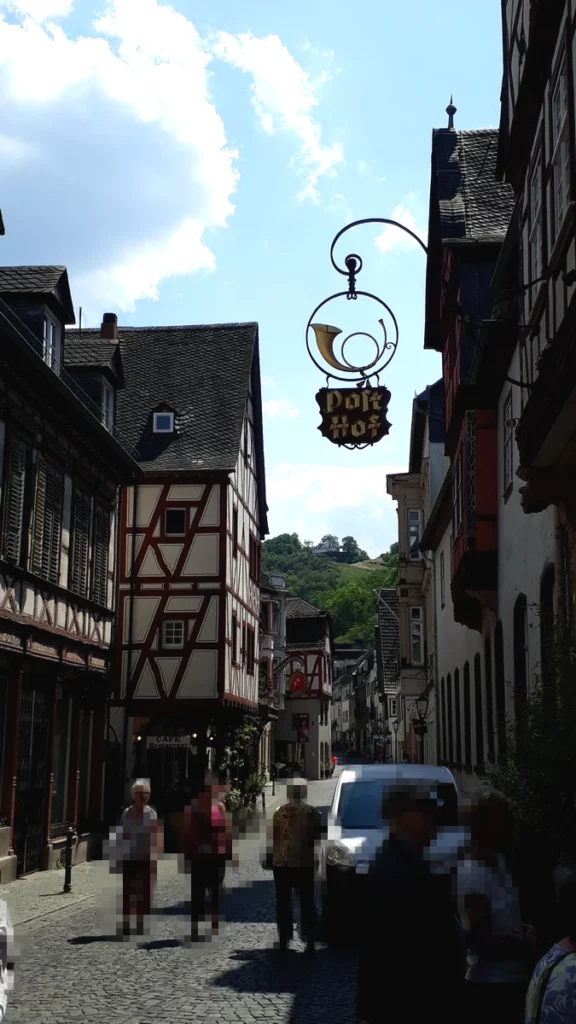
The oldest house in the region

Now we turn left, around the corner of the church, which is decorated in typical Rhenish white and red tones, where we are standing.
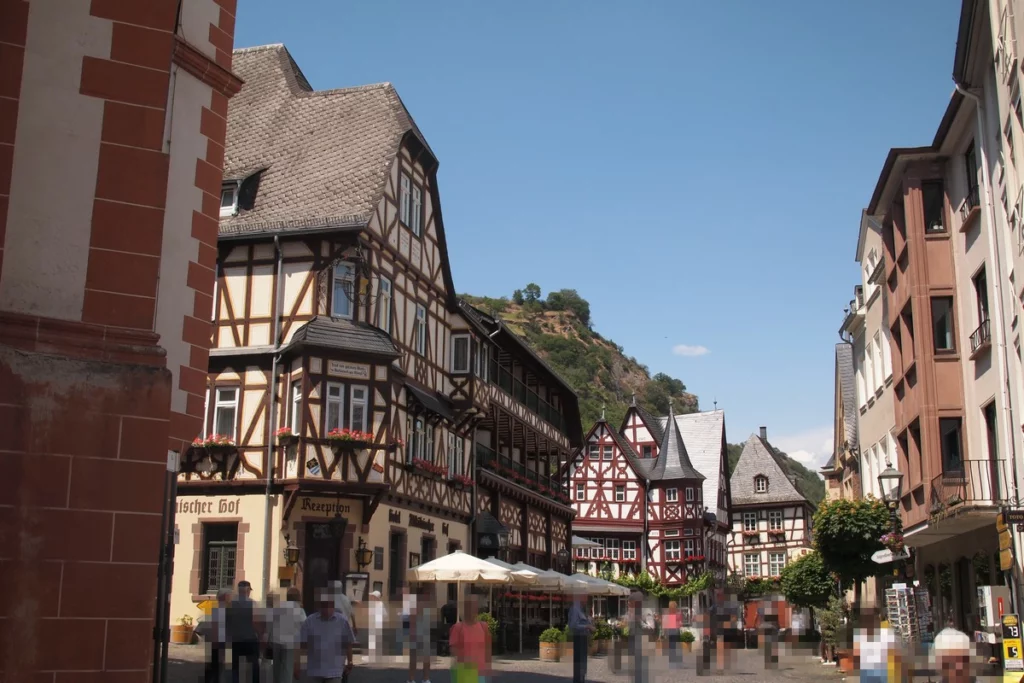
At the end of the street you will see the gate to which we will walk along the creek bank through a so-called painter’s corner (Maler Winkel).

Immediately behind the gate, a slightly uphill path leads to another tower of the city fortifications (on the first photo). The red stairs inside the empty tower are not there for beauty – you can climb them. You can also climb the stairs from the town to the tower. But first painter’s path.
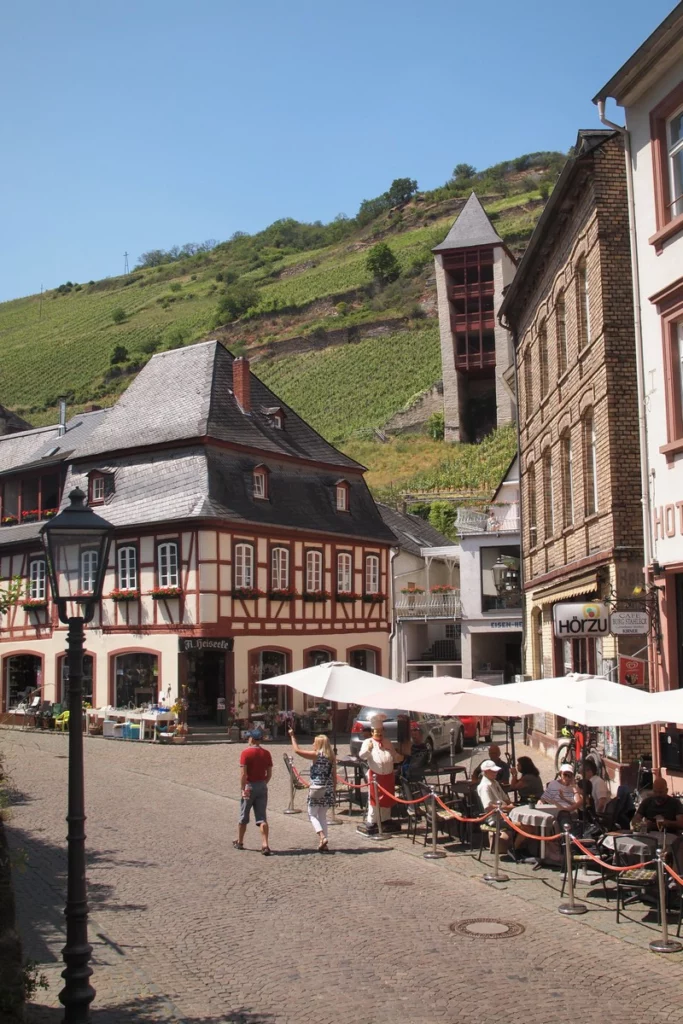
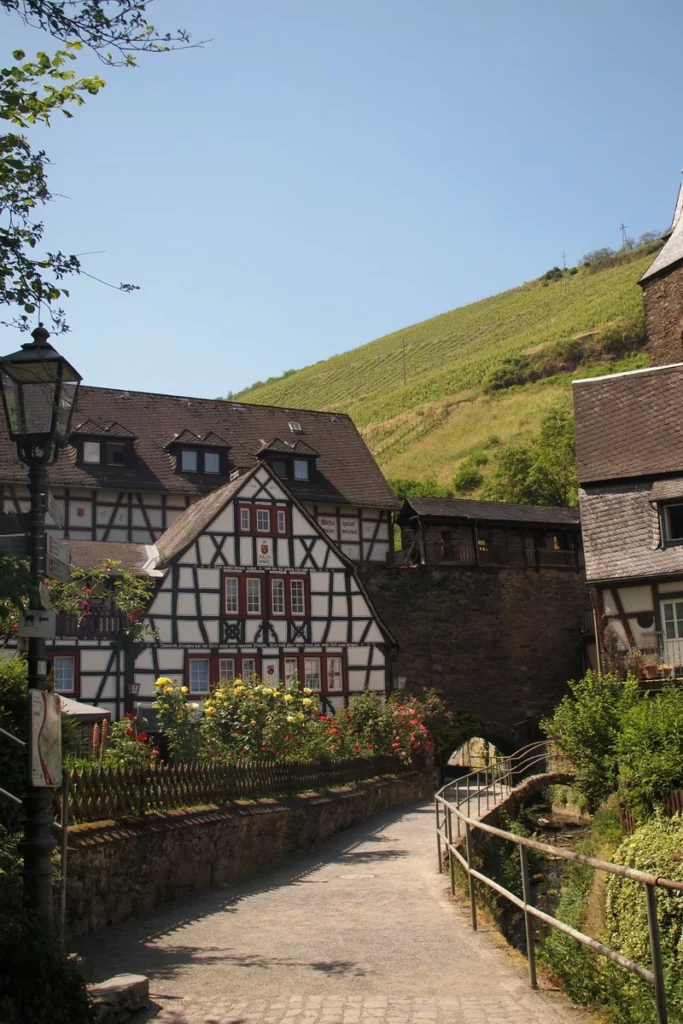
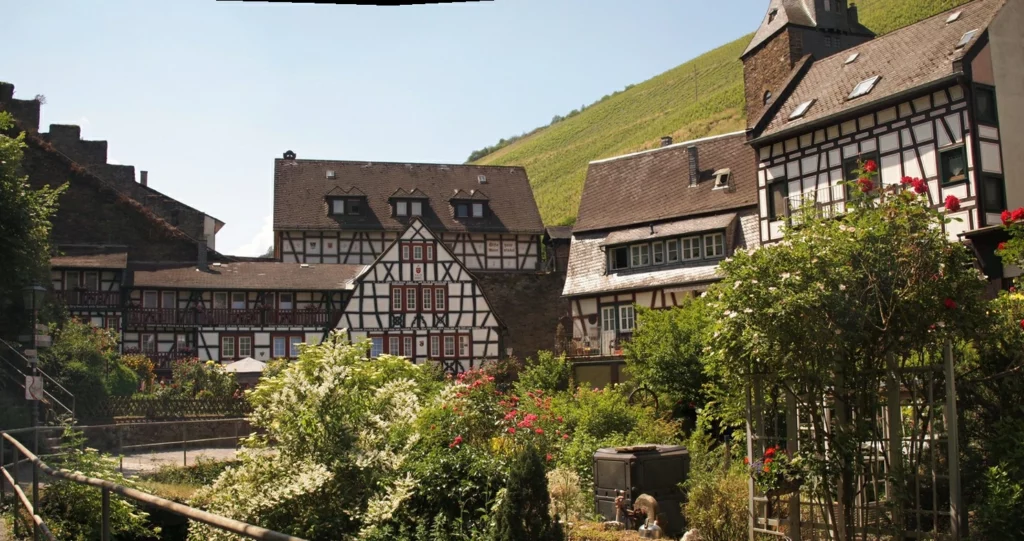
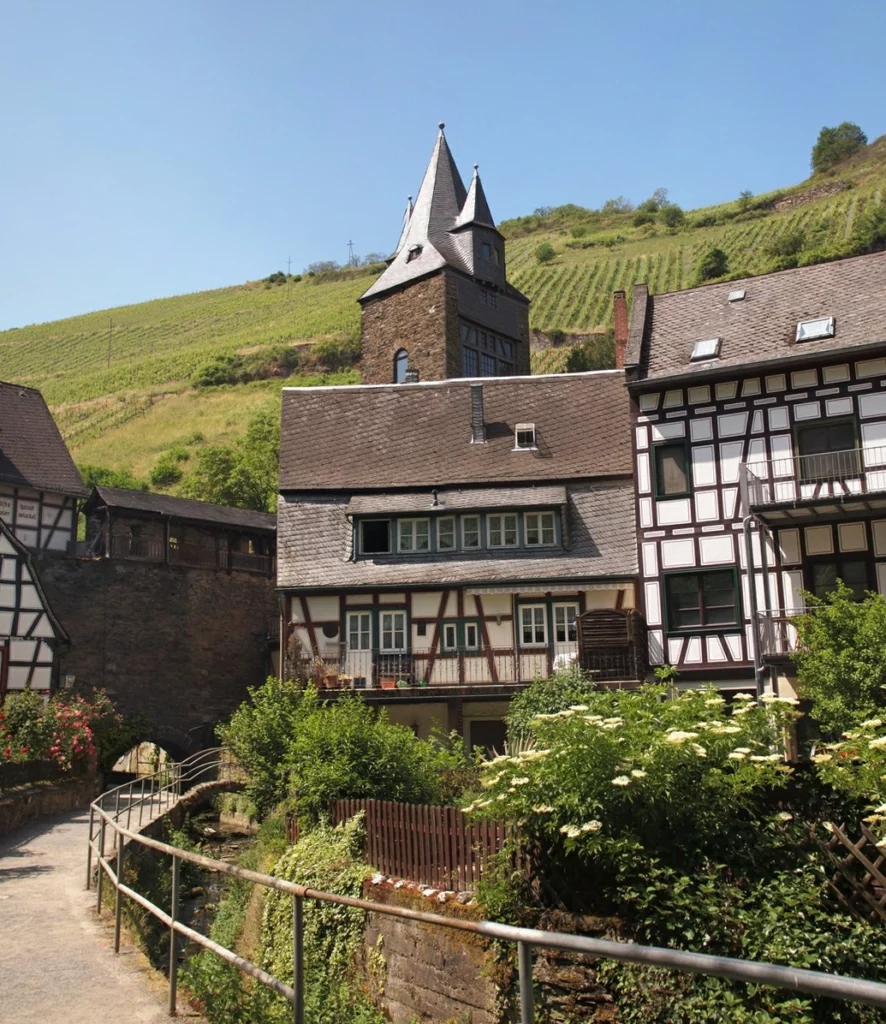

And now the view from the tower with red stairs. Opposite there are the ruins of the Werner chapel. There is also a viewing platform in front of them.
Werner is a young man found dead near Bacharach. The death was attributed to “bad” Jews, they made a saint out of the young man and used history, like others of the same kind, also “reliable”, to reprisals against the Jews. In the 20th century the church refused to venerate this “saint”. The chapel was planned to be turned into a large cathedral, but this was never completed.

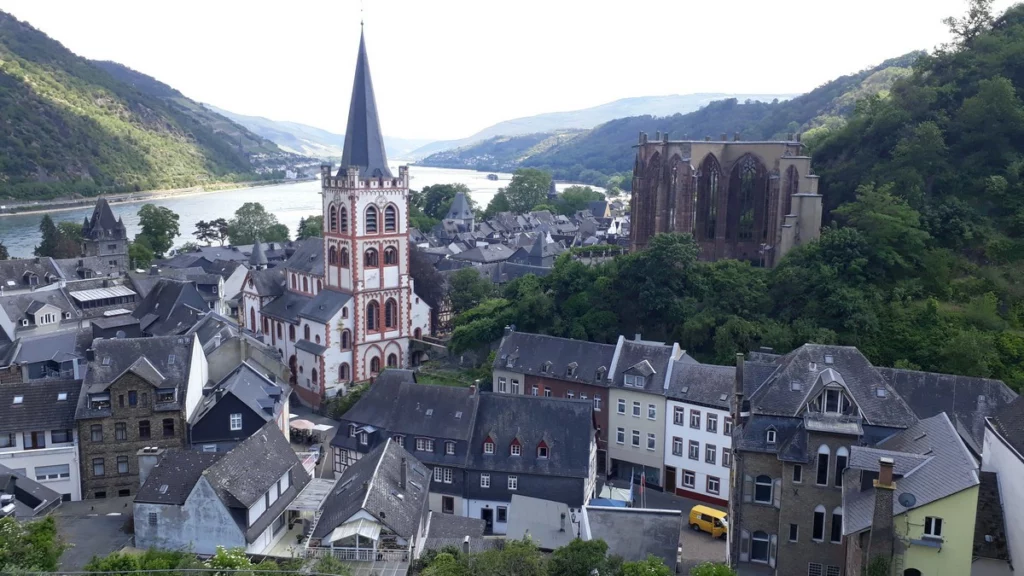
On the opposite slope there is a castle – youth hostel.
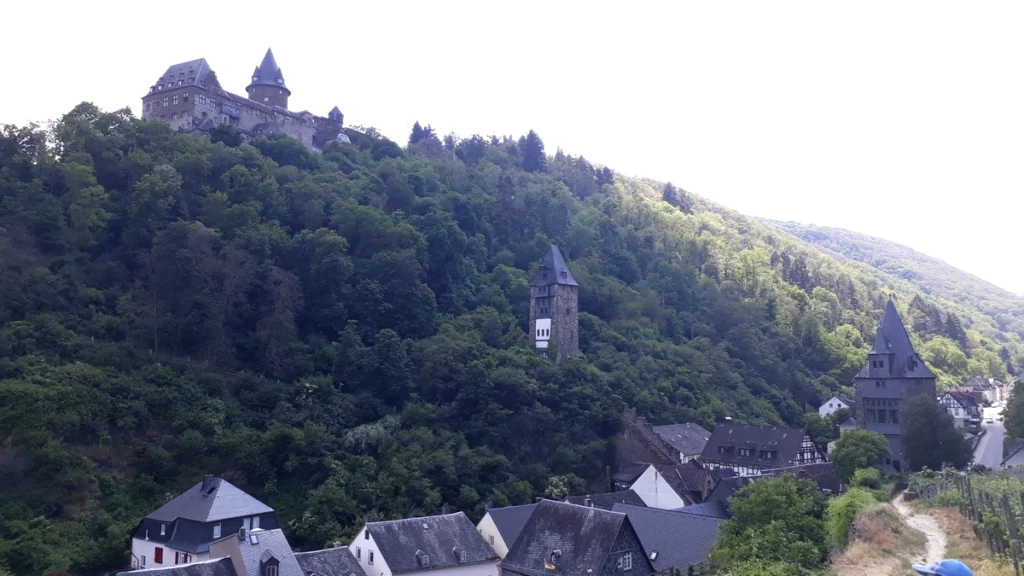
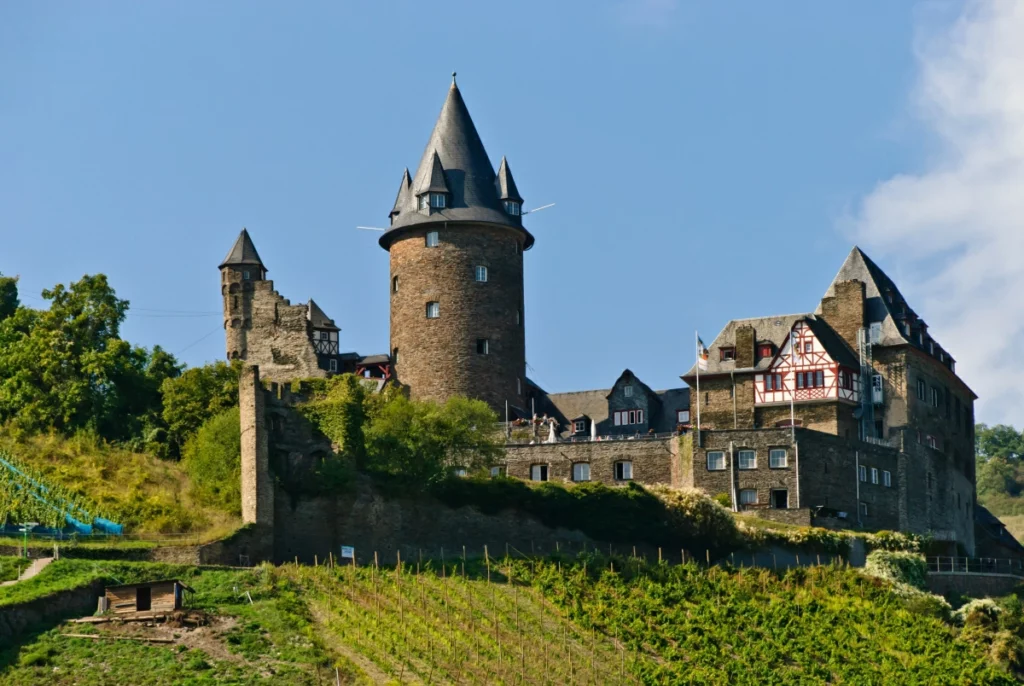
Stahleck Castle was built at the beginning of the 11th century, when the city was in the possession of the Archbishop of Cologne. In 1120 the castle was transferred to the fief of Goswin von Falkenburg. His son Hermann married the sister of King Conrad III and received the Rhine Palatinate in 1140, making Bacharach the capital of the Palatinate. After Hermann’s death, the castle and the Palatinate were given by Friedrich Barbarossa to his half-brother Konrad Hohenstaufen. Agnes, the only heiress of Conrad, secretly married in Bacharach with the son of Heinrich the Lion from the Welf family, who were enemies of the Hohenstaufen. Soon the title and castle passed back to the crown and were transferred to the Wittelsbachs. The Wittelsbachs moved to Heidelberg and Stahleck was rarely used. The castle was seriously damaged during the Thirty Years’ War and was blown up in 1689. It was rebuilt in the 20th century and now houses a youth hostel.
To be continued … Part 2 Rhine castles from Kaub to Koblenz and Lorelei rock
Attractions around Frankfurt am Main, along the Rhine to Koblenz
All posts about towns and attractions along #Rhine.
Do you enjoy the site without cookies? This means that I work for you at my own expense.
Perhaps you would like to support my work here.
Or change your cookie settings here. I don’t use personalized ads

